NetComm Wireless 3G25WR HSPA+ 21Mbps Wi-Fi Router User Manual 3G25W UG 20110211
NetComm Wireless Limited HSPA+ 21Mbps Wi-Fi Router 3G25W UG 20110211
3G25W - UG - 20110211 User manual
Overview
The NetComm 3G25W-R integrates a Wireless LAN and 3G WAN into
one unit. Connection to the Internet is achieved through either a 3G
service or via a fixed line xDSL/Cable/Satellite connection to the
3G25W-R’s WAN port, providing you with the flexibility to choose how
you access the Internet. The 3G25W-R’s automatic failover ensures
you are always connected by activating the 3G connection should the
xDSL/Cable/Satellite connection drop out.
Users are able to share a single 3G connection via both a wired and
wireless connection to the 3G25W-R. With a built in 802.11n wireless
access point, this router provides wireless speeds of up to 150Mbps,
150% faster than 11g technology¹. On top of this, the 3G25W-R has
four LAN ports for wired connections to multiple devices. Rather than
being restricted to certain USB modems, the 3G25W-R allows the
user to simply insert an active SIM and utilise 3G Mobile Broadband
for internet connectivity.
The 3G25W-R includes advanced security features such as VPN
pass-through, a full complement of wireless security options and a
built in firewall.
1 Maximum wireless signal rate and coverage values are derived from IEEE Standard 802.11g and
802.11n Draft 2.0 specifications. Actual wireless speed and coverage are dependent on network and
environmental conditions included but not limited to volume of network traffic, building materials and
construction/layout.
3G25W-R Features:
Powerful wireless router with support for 3G Mobile Broadband
Creates instant Wireless hotspots to share the Internet
connection of a 3G USB modem or DSL/Cable modem
Supports Wireless N standard with data speeds up to
150Mbps¹
One WAN port for alternate wired Internet connection
(DSL/Cable/Satellite via Ethernet)
Four LAN ports to connect wired devices like PCs or gaming
consoles
Ensures connectivity and business continuity with auto Internet
failover from WAN port to 3G Mobile Broadband
Easy WiFi Protected Setup (WPS) by the single touch of a
button to establish a secure wireless connection
Full Wireless security - WEP, WPA, WPA2
Browser based interface for configuration and management:
OS independent and easy to use
Package Contents
Your 3G25W-R Wireless Router with voice Package contains the
following items:
3G25W-R Wireless Router
Quick Installation Guide
User Guide on CD
Power Supply Unit
Ethernet Cable
If any of the above items are damaged or missing, please contact your
dealer immediately.
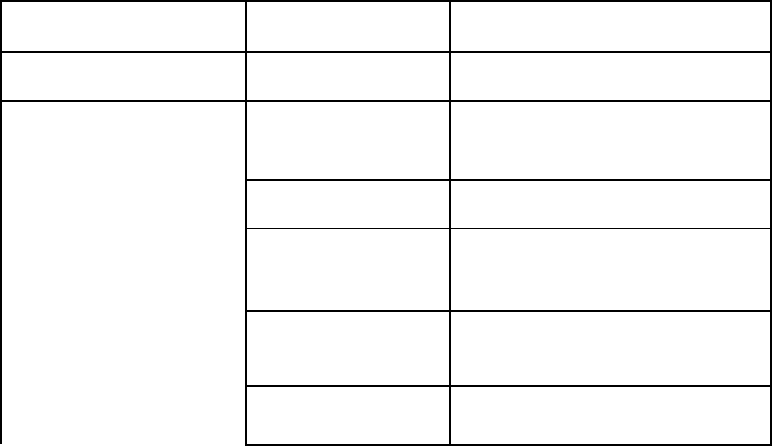
Minimum System Requirements
Before continuing with the installation of your 3G25W-R Wireless
Router, please confirm that you comply with the minimum system
requirements.
Active SIM card for 3G Broadband access if you want to use a
3G Broadband service.
Note: Subject to terms and conditions from your 3G Broadband Internet Service.
Computer with Windows, Macintosh, or Linux-based operating
systems with a working Ethernet adapter with TCP/IP Protocol
installed.
Internet Explorer version 6.0 or Netscape Navigator version 7.0
and above.
Wireless Computer System Requirements
Computer with a working 802.11b, 802.11g, 802.11n wireless
adapter
LED indicators:
(PICTURES)
LED color Description
Status Green in flash Device status is working.
Red in flash Disconnected.
No SIM card / signal or unverified
PIN code
Amber in flash Connecting.
Red Connected.
Signal strength in level one
(weak)
Red in quick flash Roaming alert, and 3G signal is
weak
3G Signal Strength LED
Amber Connected.
Signal strength in level two or

three (middle)
Amber in quick flash Roaming alert, and 3G signal is
middle
Green Connected.
Signal strength in level four or
five (strong)
Green in quick flash Roaming alert, and 3G signal is
strong
Green EDGE or GPRS connection is
established
2G/2.5G LED
Green in flash Data packet transferred via
2G/2.5G
Green UMTS/HSDPA/HSUPA
connection is established
3G/3.5G LED
Green in flash Data packet transferred via
3G/3.5G
USB / 3G LED Green Connected with 3G dongle via
USB port
Green RJ45 cable is plugged WAN LED
Green in flash Data access
Green RJ45 cable is plugged LAN LED
Green in flash Data access
Green WLAN is on
Green in flash Device is in WPS PBC mode
WiFi LED
Green in fast flash Device is in WPS PBC mode
Restoring Factory Defaults
This feature will reset the Router to its factory default configuration. Occasions may present
themselves where you need to restore the factory default settings on your router. Typical
situations are:
You have lost your password and unable to login to the router;
You have purchased the router from someone else and need to reconfigure the
device.
You are asked to perform a factory reset by a member of the excellent NetComm
Support Staff.
In order to restore your router to its factory default settings, please follow these steps:
Ensure that the router is powered on (for at least 20 seconds).
Use a paper clip or a pencil tip to depress the reset button for ten seconds and
release. At this point, the reset is in progress. Do not power off the unit at this point.
After the router reboots, the default settings are now restored. This entire process
takes several minutes to complete.
Once you have reset the router to its default settings you will be able to access the
device’s web configuration using http://192.168.1.1 with password “admin”.
Default Settings
LAN (Management)
Static IP Address: 192.168.1.x
Subnet Mask: 255.255.255.0
Default Gateway: 192.168.1.1
WAN (Internet)
WAN mode: DHCP
Wireless
SSID: (refer to the wireless security card insert)
Security: WPA2-PSK
WEP Key: (refer to the wireless security card insert)
Modem Access
Password: admin
Connecting your 3G25W-R Wireless Router
Step 1: Attach the antenna.
1. Remove the antenna from its plastic wrapper.
2. Screw the antenna in a clockwise direction to the back panel of the unit.
3. Once secured, position the antenna upward at its connecting joint. This will ensure optimal
reception.
4. And pull out the “USIM/SIM & PWR” labelled tag.
5. Ensure the Power Switch is off.
DO NOT connect the 3G25W-R to power before performing the installation
steps below.
Step 2: Insert a SIM/USIM into the 3G25W-R.
Step 3: Insert the Ethernet cable into the LAN Port:
Insert the Ethernet cable into LAN port on the back panel of the 3G25W-R, and an available
Ethernet port on the network adapter on the computer you will use to configure the 3G25W-R.
Step 4: Power on the 3G25W-R:
1. Connect the power adapter to the receptor on the back panel of your 3G25W-R.
2. Then plug the other end of the power adapter into a wall outlet or power strip.
3. Turn on the Power Switch.
Step 5: Complete the setup.
1. All LEDs will flash to indicate power has been applied.
2. The LEDs will flash ON and OFF as the 3G25W-R performs its startup initialisation and
Internet connection processes. This will take a few minutes.
3. When complete, the Status LED will flash.
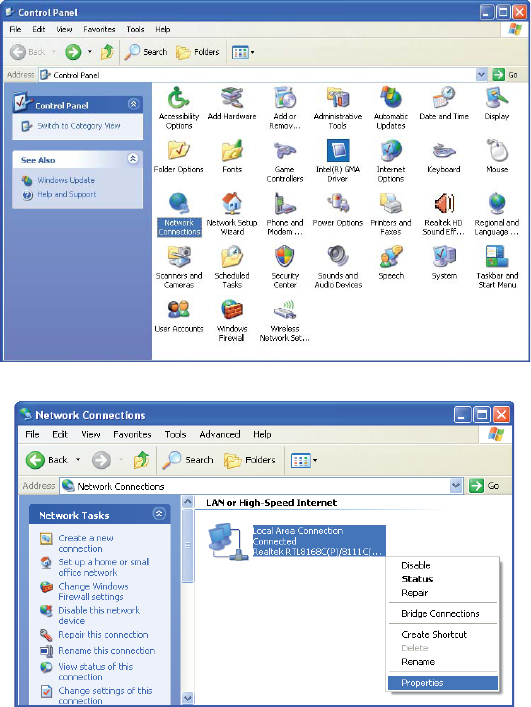
SettingupyourPC
Having physically connected your 3G25W-R, the next step is to configure the router to
establish a broadband connection. Depending on your computers current settings you may
first need to reconfigure the TCP/IP (Network Settings) to access your Wireless Router.
Follow the instructions for your operating system.
ForWindows98SE/ME/2000/XP
1. Click on “Start” -> “Control Panel” (in Classic View). In the Control Panel; double click on
“Network Connections” to continue.
2. Single RIGHT click on “Local Area connection”, then click “Properties”.
3. Double click on “Internet Protocol (TCP/IP)”.
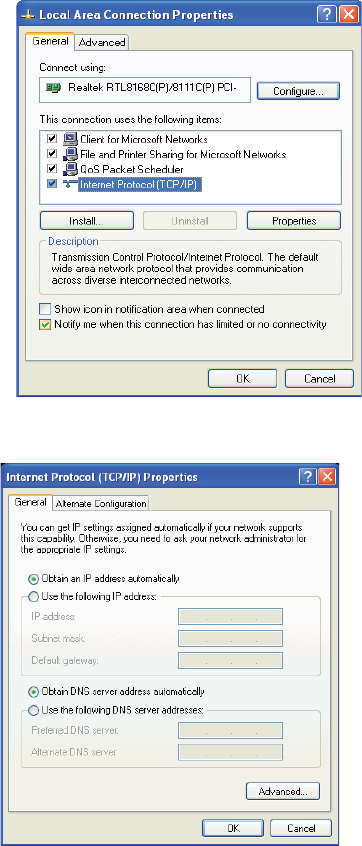
4. Check “Obtain an IP address automatically” and “Obtain DNS server address automatically”
then click on “OK” to continue
5. Click “Show icon in notification area when connected” (see screen image in 3. above) then click on
“OK” to complete the setup procedures.
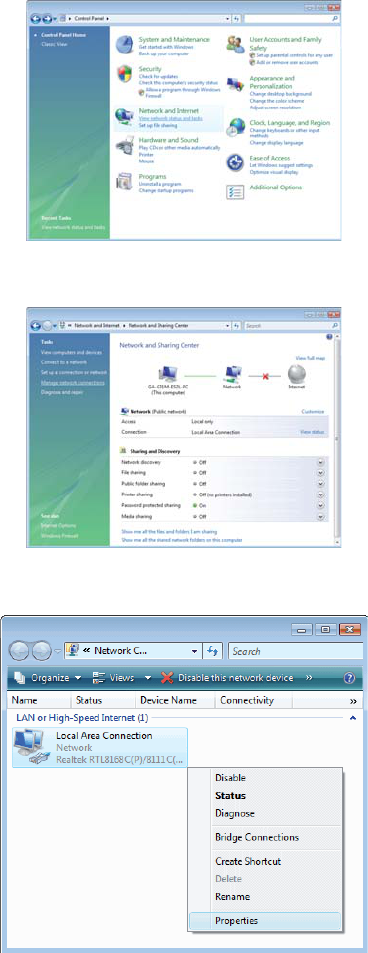
ForWindowsVista32/64
1. Click on “Start” -> “Control Panel” -> “Network and Sharing Center”.
2. In the Manage network connections, click on “Manage network connections” to continue.
3. Single RIGHT click on “Local Area connection”, then click “Properties”.
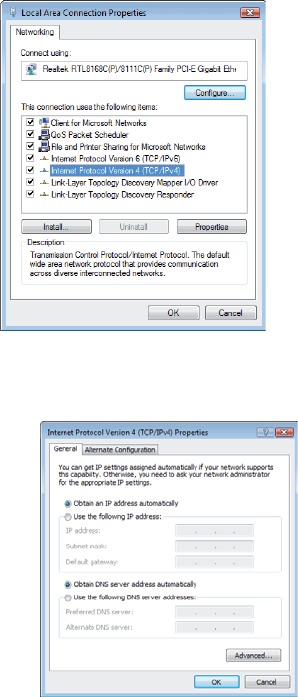
4. The screen will display the information “User Account Control” and click “Continue” to continue.
5. Double click on “Internet Protocol Version 4 (TCP/IPv4)”.
6. Check “Obtain an IP address automatically” and “Obtain DNS server address automatically”
then click on “OK” to continue.
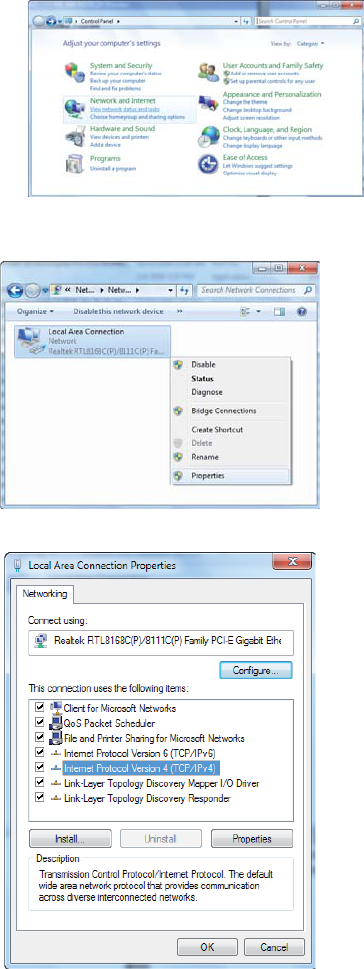
ForWindows732/64
1. Click on “Start” -> “Control Panel” (in Category View) -> “View network status and tasks”.
2. In the Control Panel Home, click on “Change adapter settings” to continue.
3. Single RIGHT click on “Local Area Connection”, then click “Properties”.
4. Double click on “Internet Protocol Version 4 (TCP/IPv4)”.
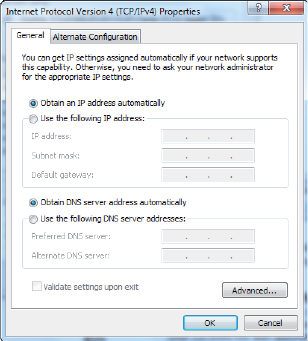
5. Check “Obtain an IP address automatically” and “Obtain DNS server address automatically”
then click on “OK” to continue.
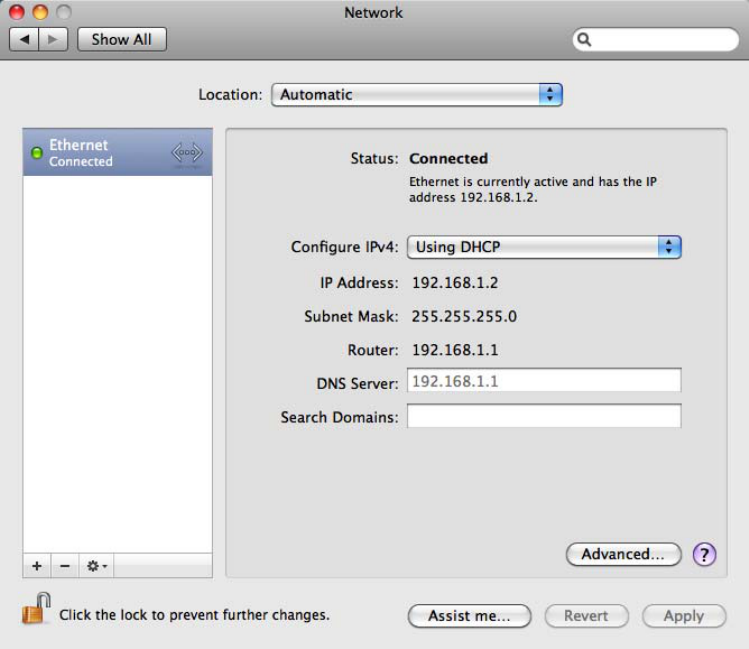
ForMacOSX10.6
1. Click the Apple icon and choose System Preferences.
2. Click on Network icon.
3. Set Location to Automatic and Show to Built-In Ethernet.
4. In the Configure option, choose Using DHCP.
5. Click on Apply Now.
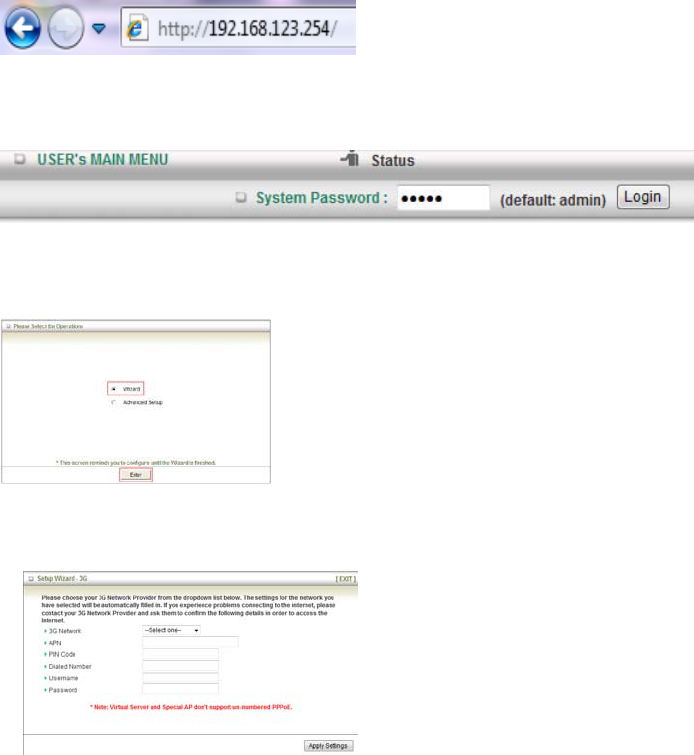
Web Configuration Wizard
Having physically connected your 3G25W-R, the next step is to establish the broadband
connection to the internet. Please follow the steps below to configure your 3G25W-R Wireless
router via the web configuration wizard utility.
1. Open your web browser (e.g. Internet Explorer/Firefox/Safari) and navigate to
http://192.168.1.1/
2. At the login screen, type in “admin” (without quotes) in the System Password field. Then
click on Login.
Notes: admin is the default login password for the unit.
3. Click on Wizard and then on Enter.
4. This page shows you the steps needed to configure your 3G25W-R unit. Click Next to
continue.
1.
2.
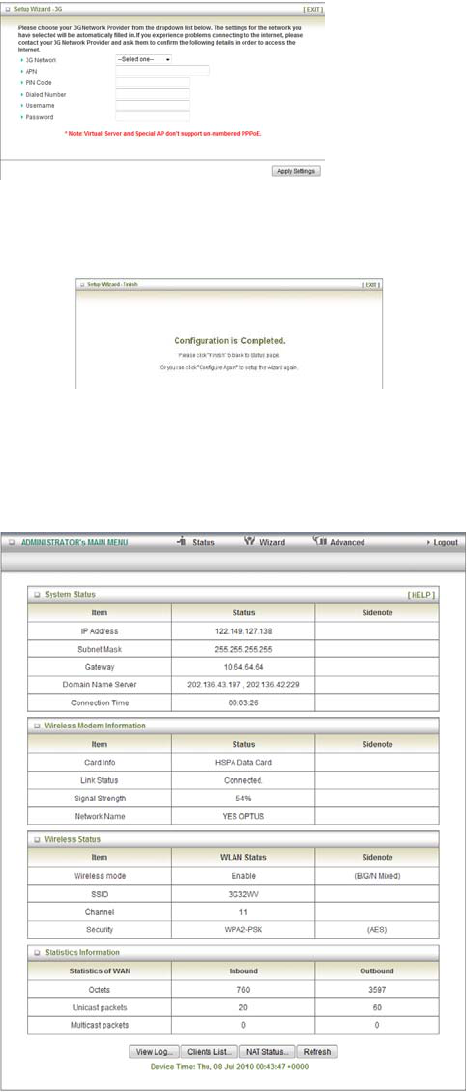
5. After choosing 3G, you need to enter the information below, this will have been provided
to you by your 3G broadband service provider. Click Apply Setting once you finished.
6. . After several minutes the 3G25W-R will save all the settings and the wizard is
complete. Click Finish to go back to the Status page and the unit will now use the new
settings.
7. If everything is configured properly, the
System Status page will show that your 3G service is online and the WAN IP address that has
been assigned.
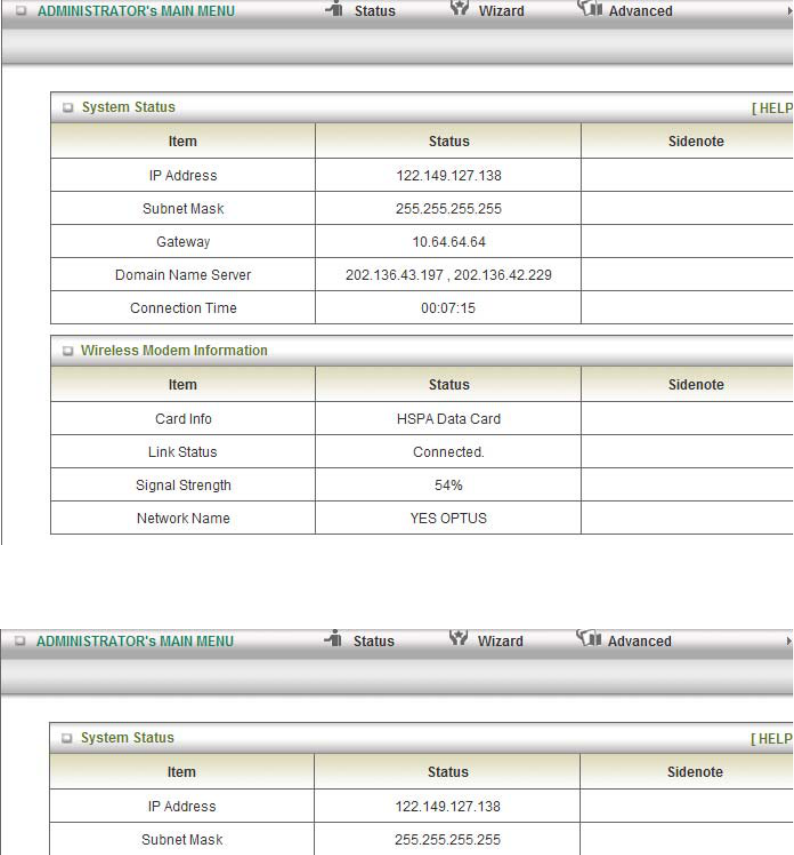
Advanced Setup
To access the Advanced Setup option of your 3G25W-R, you need to access the 3G25W-R’s
web configuration outlined in the Web configuration section and click on the Advanced Setup
menu at the top of the page.
For first time installation, you will be presented with the following page. Choose Advanced to
access the Advanced Setup page.
After that, click on any of the top menu to access the respective setting pages.

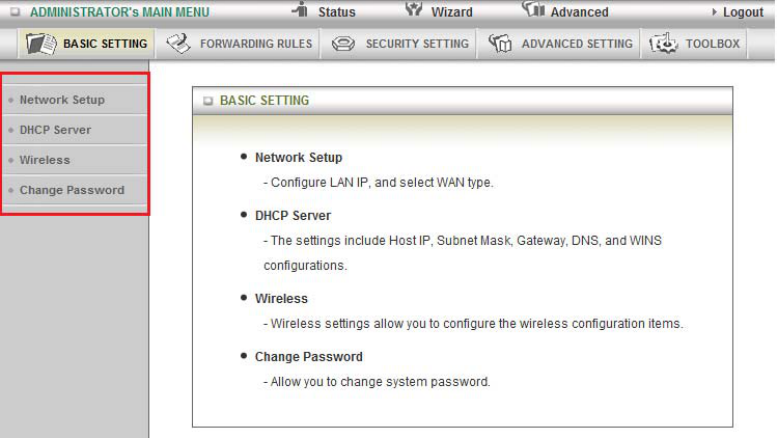
B
a
s
i
c
S
e
tt
i
ng
The Basic Setting page allows you to configure a number of basic settings on the unit. This
section deals with these features. Click on any of the menu on the left to configure the
respective setting page.
BasicSetting>NetworkSetup
This Page allows you to change the LAN (Local Area Network) settings on your 3G25W-R
Wireless router and the WAN (Wide Area Network) connection.
1. LAN IP Address: the local IP address of the 3G25W-R. The computers on your network must use this
IP address as their Default Gateway. You can change it if necessary.
2. Subnet Mask: Enter 255.255.255.0 in the subnet field.
3. WAN Interface: Select Ethernet WAN or Wireless WAN.
4. WAN Type: WAN connection type. Click the WAN Type pulldown menu to choose the appropriate
connection type from the following options:
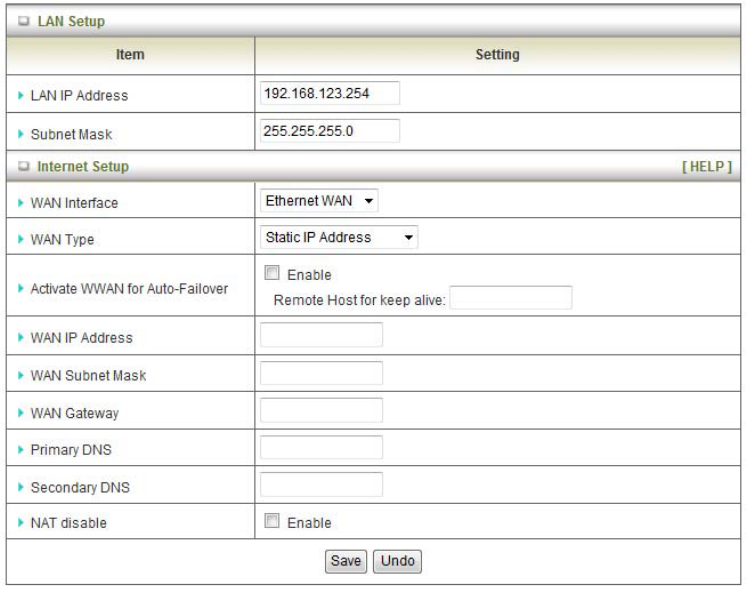
- Static IP Address
Enter the WAN IP Address, Subnet Mask, Gateway, Primary and Secondary DNS as supplied
by your ISP.
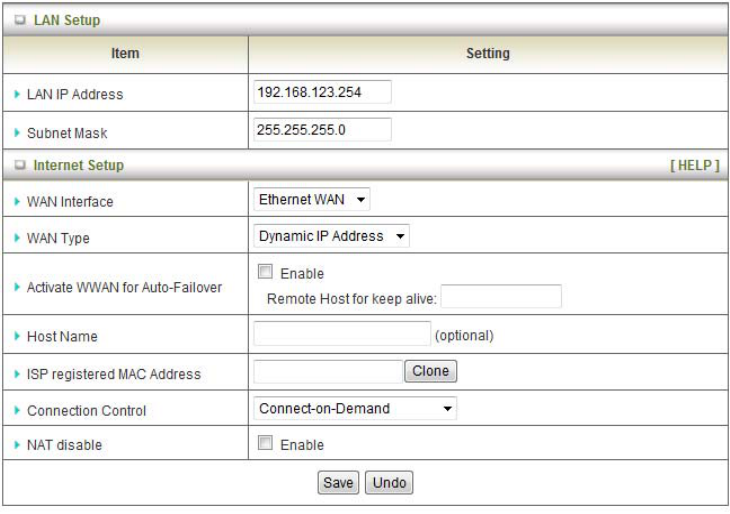
- Dynamic IP Address
Activate WWAN for Auto-Failover: The WAN type will be change to wireless-WAN automatically
if the wired-WAN connection disconnects.
Host Name: Set the hostname for your connection (optional - Refer to your ISP for more
information).
ISP register MAC address: You can change the WAN port MAC address if needed to clone
your 3G modem (optional - Refer to your ISP for more information).
Connection Control: There are 3 modes to select :-
Connect-on-demand: The 3G25W-R will connect to the internet when a client sends outgoing
packets.
Auto Reconnect (Always-on): The 3G25W-R will automatically reconnect to the internet until
the connection is manually disconnected.
Manually: The 3G25W-R will not connect to the internet until someone clicks the connect
button in the Status-page.
NAT disable: This option disables "Network Address Translation" for this connection type.
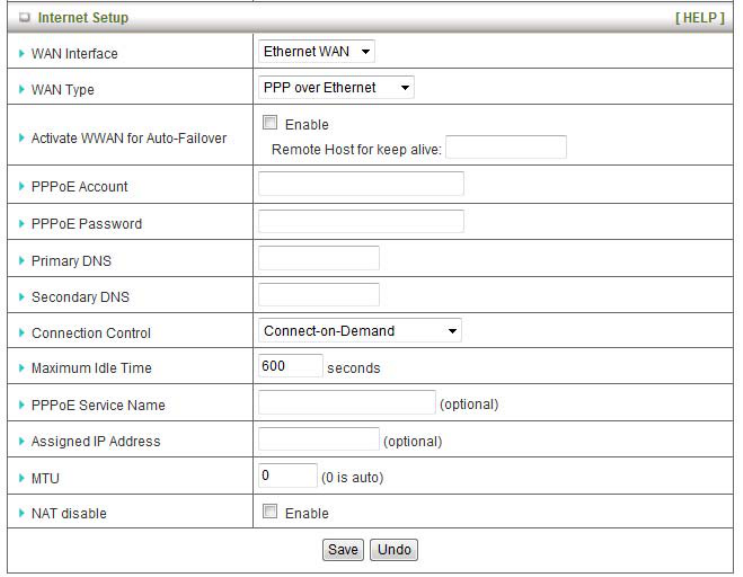
- PPP over Ethernet
Activate WWAN for Auto-Failover: The WAN type will be change to wireless-WAN automatically
if the wired-WAN connection disconnects.
PPPoE Account and Password: The account and password your ISP assigned to you. For
security, this field appears blank. If you don't want to change the password, leave it empty.
Primary DNS/Secondary DNS: This feature allows you to manually assign a Primary/Secondary
DNS Server (Refer to your ISP for more information).
Connection Control: There are 3 modes to select :-
Connect-on-demand: The 3G25W-R will connect to the internet when a client sends
outgoing packets.
Auto Reconnect (Always-on): The 3G25W-R will automatically reconnect to the
internet until the connection is manually disconnected.
Manually: The 3G25W-R will not connect to the internet until someone clicks the
connect button in the Status-page.
Maximum Idle Time: The amount of inactivity on the internet connection before it is
disconnected. Set it to zero or enable “Auto-reconnect" to disable this feature.
PPPoE Service Name: Enter the service name if your ISP requires it (optional).
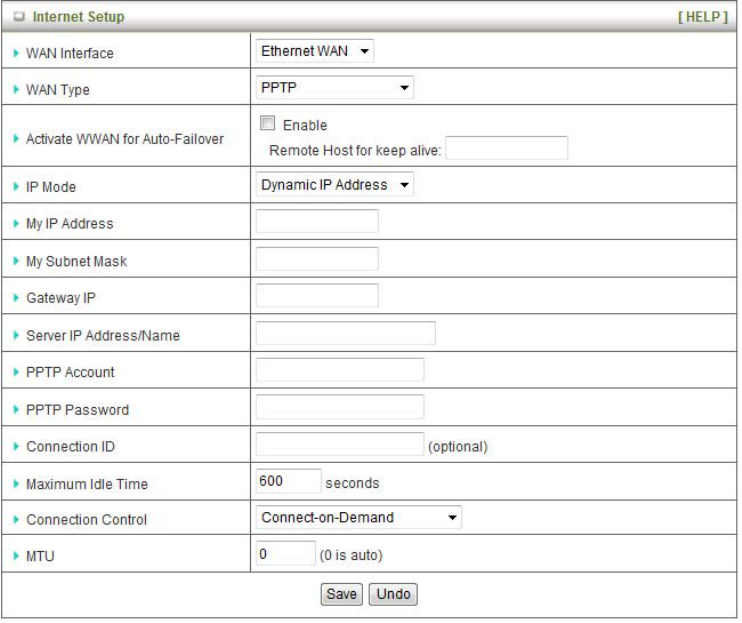
Assigned IP address: Enter the IP address assigned to your service. This is usually left blank.
Maximum Transmission Unit (MTU): The default MTU value is 0(auto). It is set automatically
when you connect.
NAT disable: This option disables "Network Address Translation" for this connection type.
- PPTP
Please verify your connection type and select the appropriate IP Mode - Static IP Address or Dynamic IP
Address.
If you are using a Static address enter the information provided to you by your service provider.
Activate WWAN for Auto-Failover: The WAN type will be change to wireless-WAN automatically
if the wired-WAN connection disconnects.
My IP Address, My Subnet Mask and WAN Gateway IP: the private IP address, subnet mask
and Gateway IP your service provider assigned to you.
Server IP Address/Name: the IP address or URL of the PPTP server.
PPTP Account and Password: The account and password your PPTP provider assigned to you.
If you don't want to change the password, keep it empty.
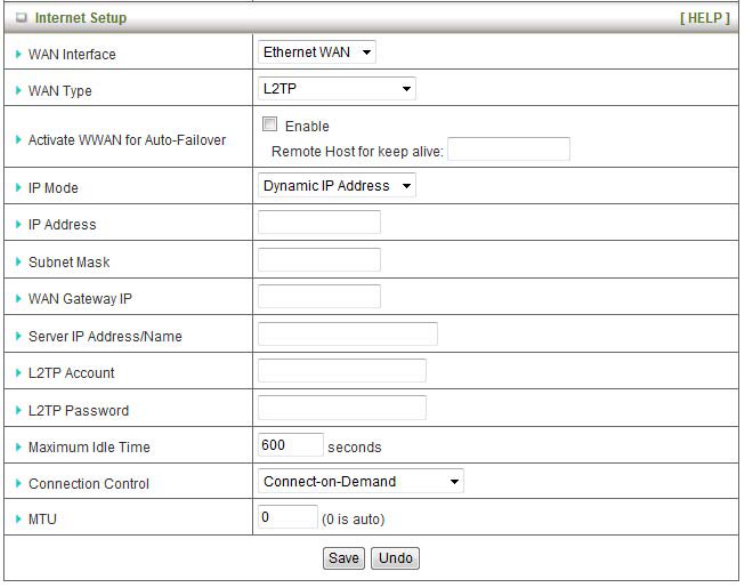
Connection ID: Enter your connection ID if required.
Maximum Idle Time: The amount of inactivity on the internet connection before it is
disconnected. Set it to zero or enable “Auto-reconnect" to disable this feature.
Connection Control: There are 3 modes to select :-
Connect-on-demand: The 3G25W-R will connect to the internet when a client sends
outgoing packets.
Auto Reconnect (Always-on): The 3G25W-R will automatically reconnect to the
internet until the connection is manually disconnected.
Manually: The 3G25W-R will not connect to the internet until someone clicks the
connect button in the Status-page.
Maximum Transmission Unit (MTU): The default MTU value is 0(auto). It is set automatically
when you connect.
- L2TP
Please verify your connection type and select the appropriate IP Mode - Static IP Address or Dynamic IP
Address.
If you are using a Static address enter the information provided to your by your service provider.
Activate WWAN for Auto-Failover: The WAN type will be change to wireless-WAN automatically
if the wired-WAN connection disconnects.
IP Address, Subnet Mask and WAN Gateway IP: the private IP address, subnet mask and
Gateway IP your service provider assigned to you.
Server IP Address/Name: The IP address or URL of the L2TP server.
L2TP Account and Password: The account and password your L2TP provider assigned to you.
If you don't want to change the password, keep it empty.
Maximum Idle Time: The amount of inactivity on the internet connection before it is
disconnected. Set it to zero or enable “Auto-reconnect" to disable this feature.
Connection Control: There are 3 modes to select :-
Connect-on-demand: The 3G25W-R will connect to the internet when a client sends
outgoing packets.
Auto Reconnect (Always-on): The 3G25W-R will automatically reconnect to the
internet until the connection is manually disconnected.
Manually: The 3G25W-R will not connect to the internet until someone clicks the connect
button in the Status-page.
Maximum Transmission Unit (MTU): The default MTU value is 0(auto). It is set automatically
when you connect.
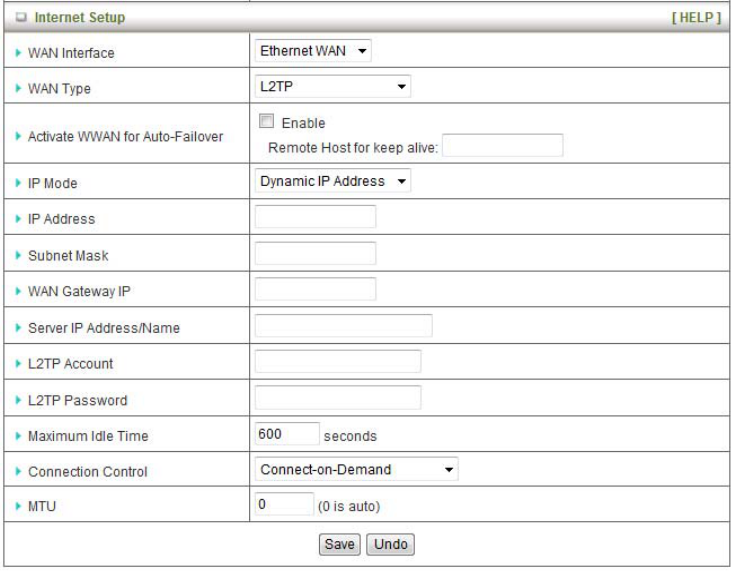
- 3G
Please note: The WAN fields may not be necessary for your 3G connection. The information on this
page will only be used when required by your 3G service provider.
Please contact your 3G provider to obtain this information if needed.
Dial-Up Profile: Select auto or manual to continue.
Country: select your country.
Telecom: select your 3G provider.
3G Network: select the 3G Network type.
APN: Enter the APN for your 3G service.
Pin Code: Enter the Pin Code for your SIM card.
Dial-Number: This number required to connect to your 3G service.
Account: The username provided by your 3G service provider to enable access to your 3G
service.
Password: The password provided by your 3G service provider to enable access to your 3G
service.
Authentication: Choose the appropriate authentication type for your 3G service.
Primary DNS: Manually assign a Primary DNS Server.
Secondary DNS: Manually assign a Secondary DNS Server.
Connection Control: There are 3 modes to select :-
Connect-on-demand: The 3G25W-R will connect to the internet when a client sends
outgoing packets.
Auto Reconnect (Always-on): The 3G25W-R will automatically reconnect to the
internet until the connection is manually disconnected.
Manually: The 3G25W-R will not connect to the internet until someone clicks the
connect button in the Status-page.
Keep Alive: Enables the 3G25W-R to maintain your internet connection.
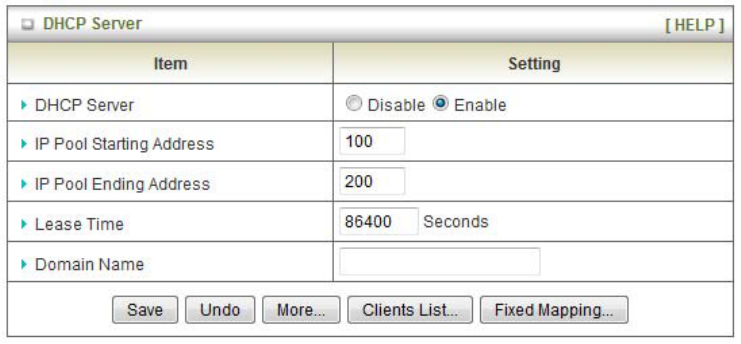
BasicSetting>DHCPServer
1. DHCP Server: Enable or disable the DHCP server.
2. Lease Time: Length of the DHCP lease time
3. IP Pool Starting/Ending Address: Whenever there is a request, the DHCP server will automatically allocate
an unused IP address from the IP address pool to the requesting computer. You must specify the starting / ending
address of the IP address pool
4. Domain Name: Optional, this information will be passed to the client
Click “Save” to save these settings or Undo to cancel.
You can also check the DHCP client list by pressing the Client List button.
Fixed Mapping button allows you to map a specific IP address to a specific MAC address.
Press “More…” for more options,
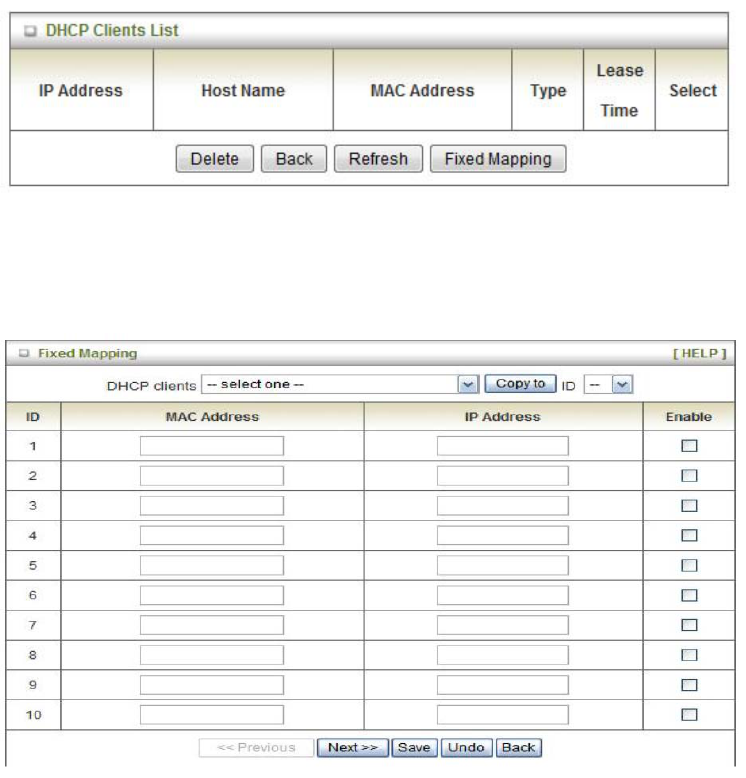
DHCPClientsList
The list of DHCP clients is shown here.
DHCPFixedMapping
The DHCP Server will reserve a specific IP for a specific MAC address, shown below.
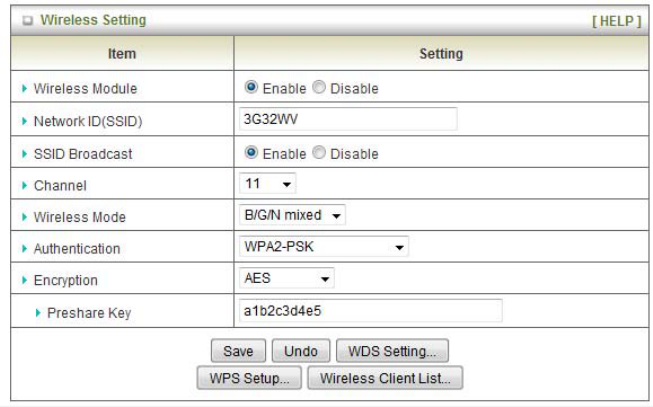
BasicSetting>Wireless
This page allows you to configure the wireless network features of the router.
The Wireless settings page allows you to set the wireless configuration items.
1. Network ID (SSID): Network ID is used for identifying the Wireless LAN (WLAN). Client stations can roam
freely over this product and other Access Points that have the same Network ID. (The factory default setting
is “3G25W-R”)
2. SSID Broadcast: The router will broadcast the SSID so that wireless clients can find the wireless network.
3. Channel: The wireless radio channel in use by your network.
4. Wireless Mode: Choose B/G Mixed, B only, G only, and N only, G/N Mixed or B/G/N mixed. The factory
default setting is B/G/N mixed.
5. Authentication mode: You may select from seven kinds of authentication to secure your wireless network:
Open, Shared, Auto, WPA-PSK, WPA2-PSK, and WPA-PSK/WPA2-PSK.
WPA-PSK/WPA2-PSK - A newer type of security is WPA-PSK-TKIP and WPA-PSK2-ADE. This type of security gives a
more secure network compare to WEP. Use TKIP Encryption Type for WPA-PSK and AES for WPA2-PSK. Please
enter the key in the Passphrase field. The key needs to be more then 8 characters and less then 63 characters and it
can be any combination of letters and numbers.
The factory default setting is: a1b2c3d4e5
Please note that the configuration for WPA-PSK and WPA2-PSK is identical
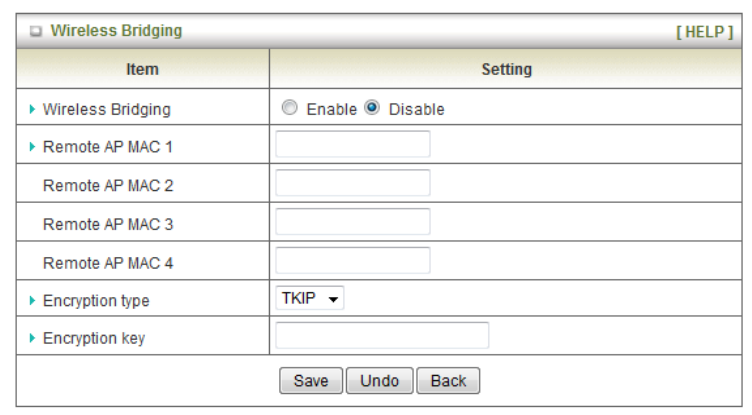
Notes: After configuring wireless security, you also need to configure your wireless adapter to use the same
security settings before you can connect wirelessly. Not all wireless adapter supports WPA-PSK/WPA2-
PSK/WPA/WPA2 security, please refer to your wireless adapter user guide for more details. It is strongly recommended
to set up wireless security such as WPA-PSK (when the wireless client supports WPA) in order to secure your network.
Click “Save” to save these settings or click “Undo” to cancel.
WDS(WirelessDistributionSystem)
WDS operation as defined by the IEEE802.11 standard has been made available. Using WDS it is possible to wirelessly
connect Access Points, and in doing so extend a wired infrastructure to locations where cabling is not possible or
inefficient to implement.
WPSSetup
WPS is a Wi-Fi Protection Setup which is similar to WCN-NET and offers safe and easy way to connect Wirelessly.
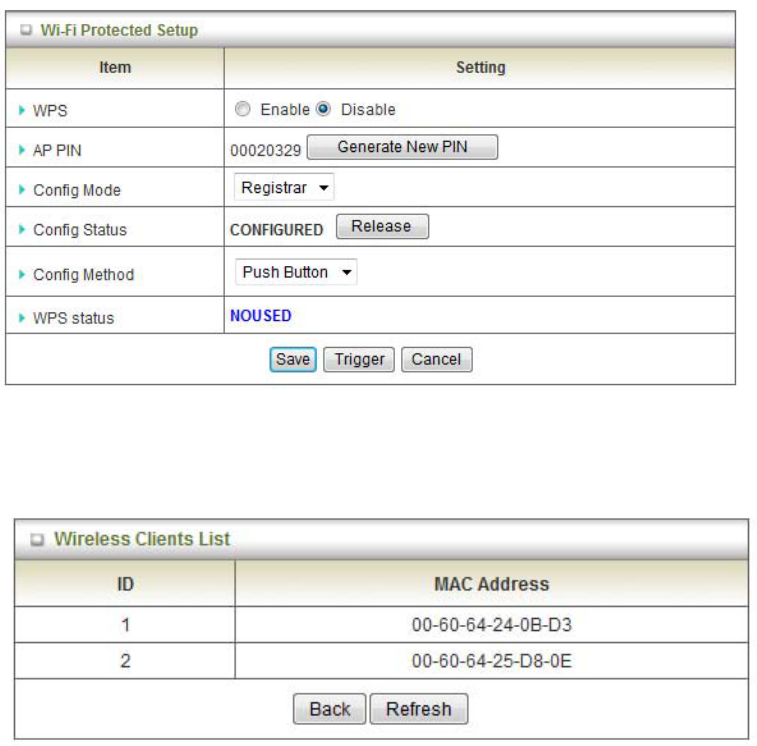
WirelessClientList
The list of wireless clients is shown here.
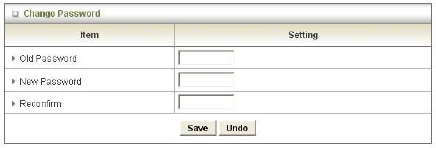
BasicSetting>ChangePassword
On this page you can change the 3G25W-R web configuration password. Please type in your old password
(the factory default password is admin) and then type in the new password. Type the same new password in the
Reconfirm field.
Note: if you change the password, please make sure that you use the new password the next time you log into the
web configuration.
Click “Save” to save the settings or “Undo” to cancel.
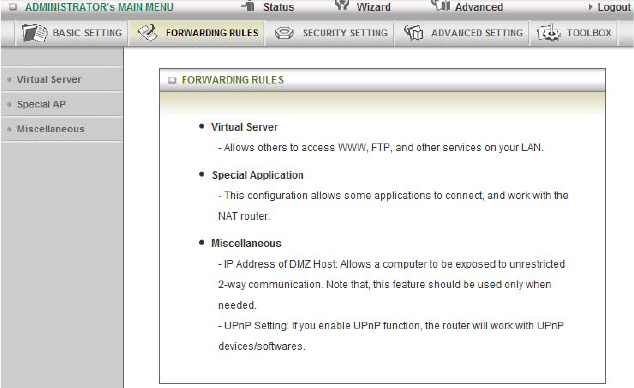
Forwarding
R
u
l
e
s
The
Forwarding
Rules
page
allows
you
to
configure
the
port
f
orwarding
management
on
the
router.
Click
on
an
y
of
the
menu
items
on
the
left
to
access
the
respective
settings
pa
ge.
Forwarding
rules
are
a
necessar
y
fea
ture
as
b
y
default
NA
T
(Network
Address
T
ranslation)
will
automa
ticall
y
block
incoming
traffic
from
the
Internet
to
the
LAN
unless
a
specific
port
mapping
exists
in
the
NA
T
translation
table.
Because
of
this,
NA
T
provides
a
level
of
protection
f
or
computers
tha
t
are
connected
to
your
LAN.
However
,
this
also
creates
a
connectivity
problem
when
you
want
to
make
LAN
resources
availa
ble
to
Internet
clients,
which
you
ma
y
want
to
do
to
pla
y
network
games
or
host
network
a
pplications.
There
are
three
wa
ys
to
work
around
NA
T
and
to
ena
ble
certain
LAN
resources
a
vaila
ble
from
the
Internet;
Port
Forwarding
(in
the
Virtual
Ser
ver
page),
Port
T
riggering
(in
the
Special
AP
pa
ge)
and
DMZ
Host
(in
the
Miscellaneous
page).
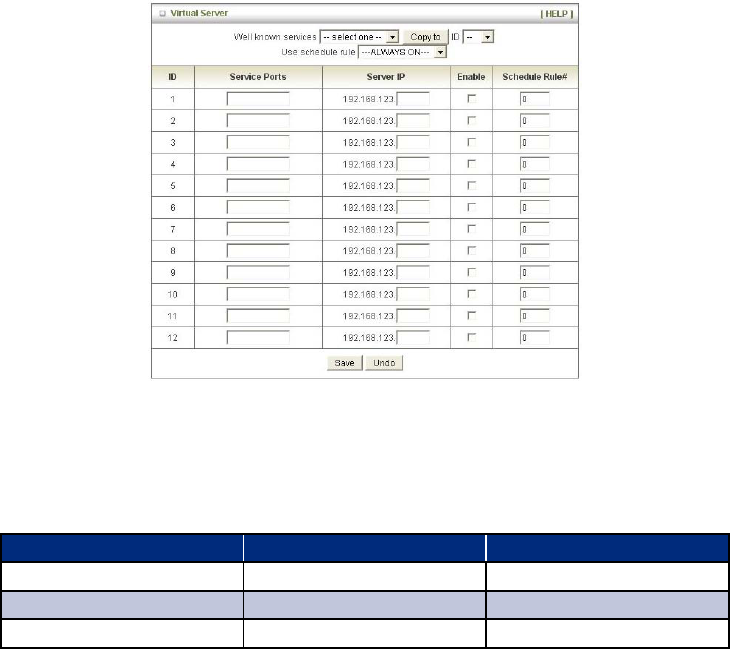
Forw
ar
ding
Rules
>
Virtual
Ser
ver
A
virtual
ser
ver
is
defined
as
a
Ser
vice
Port,
and
all
requests
to
this
port
will
be
redirected
to
the
computer
specified
b
y
the
Server
I
P
.
Virtual
Servers
can
also
work
with
Scheduling
Rules,
and
g
ive
you
more
flexibility
on
Access
control.
For
detail
instructions
on
scheduling
rules,
please
refer
to
Advanced
Setting
>
Scheduling.
For
example,
if
you
ha
ve
an
FTP
ser
ver
(default
port
is
port
21)
a
t
192.168.1.10,
a
W
eb
ser
ver
(default
port
is port
80)
a
t
192.168.1.20,
and
a
VPN
ser
ver
(default
port
is
port
1723)
a
t
192.168.1.60,
then
you
need
to specify
the
f
ollowing
virtual
ser
ver
mapping
table:
Ser
vice
.
Port
Ser
ver.
IP
Enable
21
192.168.1.10
T
icked
80
192.168.1.20
T
icked
1723
192.168.1.60
T
icked
Note:
At
an
y
g
iven
time,
onl
y
one
IP
address
can
bind
to
a
particular
Ser
vice
Port.
Click
“
Sa
ve”
to
sa
ve
the
settings
or
“
Undo”
to
cancel.
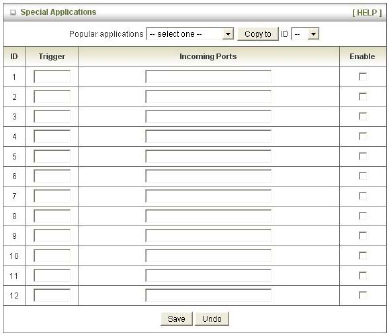
Forw
ar
ding
Rules
>
Special
AP
Some
a
pplications
like
On-line
games,
Video
conferencing
and
Internet
telephon
y
require
multiple
connections
to
the
internet.
Because
of
tha
t,
these
a
pplications
cannot
work
with
a
pure
NA
T
router
such
as
the
3G25W-R
.
The
Special
Applica
tions
fea
ture
allows
some
of
these
a
pplications
to
work
with
this
router
.
If
this
fails
to
make
the
a
pplication
work,
tr
y
to
set
up
tha
t
computer
as
the
DMZ
host
instead.
Please
refer
to
Forwarding
Rules
>
Miscellaneous
section for assistance doing this.
The
fields
are
explained
as
f
ollow:
1.
T
rig
ger:
the
outbound
port
number
tha
t
will
be
trig
gered
b
y
the
a
pplica
tion..
2.
Incoming
Ports:
when
the
trig
ger
packet
is
detected,
the
inbound
packets
sent
to
the
specified
port
numbers
will
be
allowed
to
pass
through
the
firewall.
The
3G32VW
also
provides
predefined
settings
f
or
some
popular
a
pplica
tions.
T
o
use
the
predefined
settings,
select
your
a
pplication
from
the
Popular
a
pplication
list,
select
an
unused
ID
from
the
list
and
then
click
Cop
y
to.
After
tha
t
the
predefined
settings
will
be
added
to
the
list.
Click
“
Sa
ve”
to
sa
ve
the
settings
or
“
Undo”
to
cancel.

Forw
arding
Rules
>
Miscellaneous
DMZ
(Demilitarized
Zone)
Host
is
a
computer
without
the
protection
of
firewall.
It
allows
tha
t
particular
computer
to
be
exposed
to
unrestricted
2-wa
y
communication
to
the
internet.
It
is
mostl
y
used
f
or
Internet
games,
Video
conferencing,
Internet
telephon
y
and
other
special
a
pplications.
T
o
ena
ble
DMZ,
enter
the
IP
address
of
the
PC
and
tick
on
Ena
ble.
Note:
This
fea
ture
should
be
used
onl
y
when
necessar
y
.
UPnP Setting, The device also supports this function. If the OS supports this function enable it.
Click “Save” to save the settings or “Undo” to cancel.
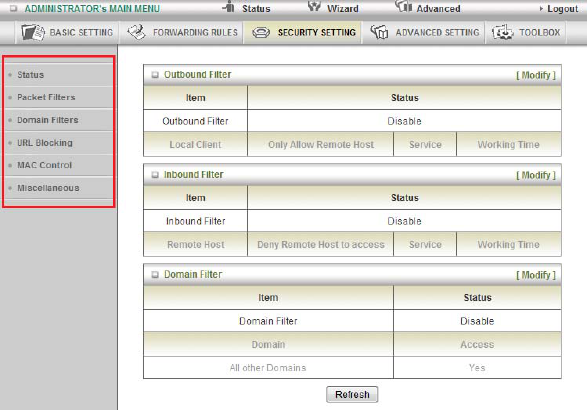
3GT2WN
S
e
c
u
r
i
t
y
S
e
tt
i
ng
The
Security
Setting
page
allows
you
to
configure
the
security
management
on
the
router
such
as
Packet
filters
and
MAC
Control.
Click
on
an
y
of
the
menu
items
on
the
left
to
access
the
respective
setting
pa
ge.
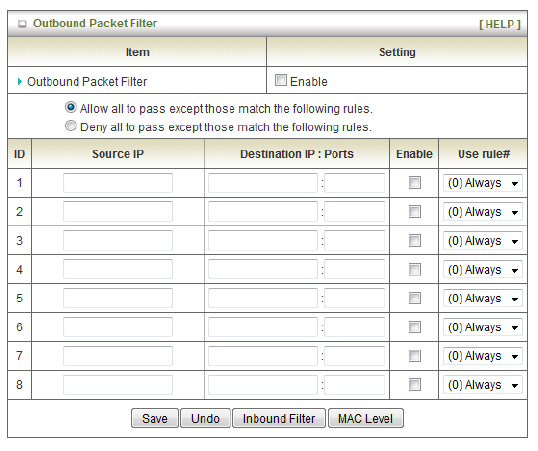
Security
Setting
>
Pac
k
et
Filters
The Packet
Filter
ena
bles
you
to
control
wha
t
packets
are
allowed
to
pass
through
the
router
.
There
are
two
types
of packet
filter
,
Outbound
Packet
Filter
which
a
pplies
to
all
outbound
packets
and
Inbound
Packet
Filter
which
onl
y
a
pplies
to
packets
tha
t
are
destined
for a
Virtual
Server
or
DMZ
host
onl
y
.
T
o
ena
ble
an
Outbound
Filter
,
please
make
sure
to
tick
the
Ena
ble
tick
box
on
the
top
of
the
pa
ge.
There
are
two
type
of
filtering
policies:
1.
Allow
all
da
ta
traffic
to
pass
except
those
that
ma
tch
the
specified
rules.
2.
Den
y
all
da
ta
traffic
to
pass
except
those
that
ma
tch
the
specified
rules.
For
each
direction,
you
can
specify
up
to
48
rules.
F
or
each
rule
you
will
need
to
define
the
f
ollowing:
•
Source
IP
address
•
Source
port
•
Destina
tion
IP
address
•
Destina
tion
port
•
Protocol:
TCP
or
UDP
or
both.
•
Use
Schedule
Rule#
For
source
or
destination
IP
address,
you
can
define
a
single
IP
address
(192.168.1.1)
or
a
range
of
IP
addresses
(192.168.1.100-192.168.1.200).
Empty
fields
impl
y
all
IP
addresses.
For
source
or
destination
port,
you
can
also
define
a
single
port
(80)
or
a
range
of
ports
(1000-1999).
Use the
prefix
“T”
or
“U”
to
specify
either the
TCP
or
UDP
protocol
e.g.
T80,
U53,
U2000-2999.
No
prefix
indicates
both
TCP
and
UDP
are
defined.
An
empty
field
implies
all
port
s.
The Packet
Filter
also
works
with
Scheduling
Rules,
and
g
ives
you
more
flexibility
on
Access
control.
For
detailed instructions
regarding
scheduling
rules,
please
refer
to
the
Advanced
Setting
>
Scheduling section.
Click
“
Sa
ve”
to
sa
ve
the
settings
or
“
Undo”
to
cancel.
Inbound
Filter:
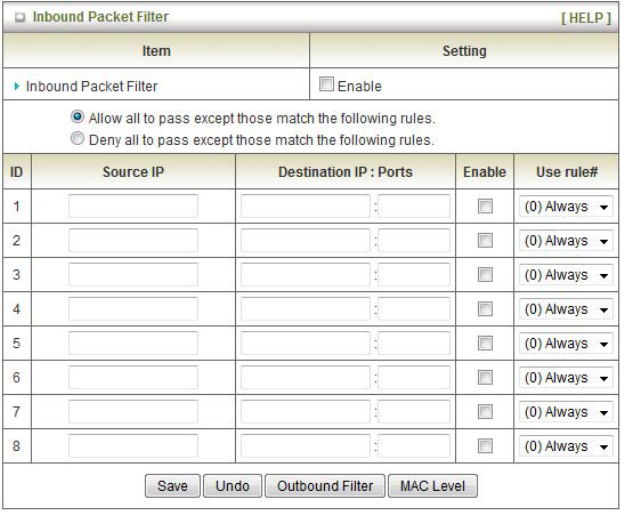
T
o
access
the
Inbound
Packet
Filter
pa
ge,
click
on the “Inbound
Filter” button
on
the
bottom
of
the
Outbound
Filter
pa
ge.
All
the settings
on
this
page
are
similar
to
the
one
f
or
the
Outbound
Filter
.
Click
“
Sa
ve”
to
sa
ve
the
settings
or
“
Undo”
to
cancel.
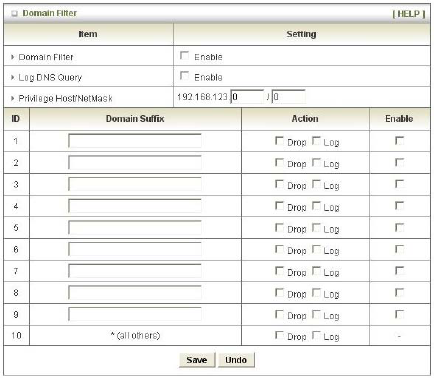
Security
Setting
>
Domain
Filters
Domain
Filters
ena
ble
you
to
prevent
users
from
accessing
specific
domain
addresses.
T
o
ena
ble
the
Domain
Filter
please
make
sure
to
tick
the
Ena
ble
tick
box
on
the
top
of
the
pa
ge.
Log
DNS
Quer
y
.
Please
tick
the
Ena
ble
tick
box
if
you
want
to
log
when
someone
accesses
specific
URLs.
Privilege
Host/Netmask.
T
o
set
a
group
of
computer
tha
t
has
privilege
to
access
the
internet
without
an
y
restriction.
T
o
set
a
Domain
Filter
,
you
need
to
specify
the
f
ollowing:
•
Domain
Suffix:
Please
type
the
suffix
of
the
URL
tha
t
needs
to
be
restricted.
For
example,
“.com”,
“xxx.
com”.
•
Action:
The
router
action
tha
t
you
want
when
someone
is
accessing
a
URL
tha
t
met
the
domain
suffix.
T
ick
on
Drop
to
block
the
access
and/or
tick
on
Log
to
log
this
access.
•
Ena
ble.
T
ick
to
ena
ble
the
rule.
Click
“
Sa
ve”
to
sa
ve
the
settings
or
“
Undo”
to
cancel.
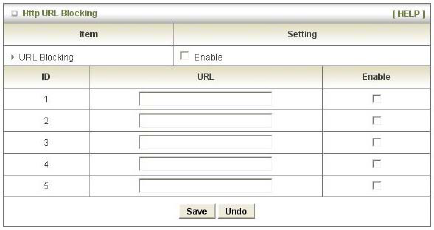
Security
Setting
>
URL
Bloc
king
URL
Blocking
will
block
LAN
computers
from
connecting
to
a
pre-defined
website
.
The
major
dif
ference
between
Domain
Filter
and
URL
Blocking
is
tha
t
Domain
Filter
require
users
to
input
a
suffix
(e.g.
xxx.com,
yyy
.net)
while
URL
Blocking
onl
y
requires
you
to
input
a
ke
yword.
T
o
ena
ble
URL
Blocking
please
make
sure
to
tick
on
Ena
ble
tick
box
on
the
top
of
the
pa
ge.
T
o
set
a
URL
Blocking
rule,
you
need
to
specify
the
f
ollowing:
•
URL.
If
an
y
part
of
the
W
ebsite’
s
URL
matches
the
pre-defined
word
then
the
connection
will
be
blocked.
For
example,
you
can
use
pre-defined
word
“sex”
to
block
all
websites
if
their
URLs
contain
the
pre-
defined
word
“sex”.
•
Ena
ble.
T
ick
to
ena
ble
the
rule.
Click
“
Sa
ve”
to
sa
ve
the
settings
or
“
Undo”
to
cancel.
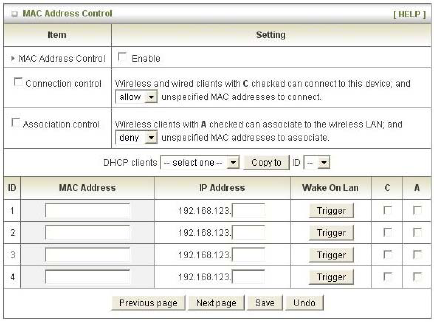
Security
Setting
>
MAC
Control
MAC
Control
allows
you
to
assign
dif
ferent
access
rights
f
or
dif
ferent
users
and
to
assign
a
specific
IP
address
to
a specific
MAC
address.
T
o
ena
ble
MAC
Address
Control
please
make
sure
to
tick
the
Ena
ble
tick
box
on
the
top
of
the
pa
ge.
T
wo
types
of
control
are
availa
ble:
•
Connection
control.
Check
Connection
Control
to
control
which
clients
(wired
and
wireless)
can
connect
to
the
unit.
If
a
client
is
denied
to
connect
to
this
device,
it
means
the
client
can
not
access
to
the
Internet either
.
Choose
allow
or
den
y
to
allow
or
den
y
clients
with
MAC
addresses
tha
t
are
not
in
the
list
to
connect
to
this
device.
•
Associa
tion
control.
Check
Associa
tion
Control
to
control
which
wireless
client
can
associa
te
with
the
unit.
If
a
client
is
denied
to
associa
te
with
the
unit,
it
means
the
client
can
not
send
or
receive
an
y
da
ta
via
this
device.
Choose
allow
or
den
y
to
allow
or
den
y
the
clients
with
MAC
addresses
tha
t
are
not
in
the
list
to
associa
te
to
the
wireless
LAN
Click
the “
Next
Pa
ge”
or
the “
Previous
Pa
ge” buttons
to
see
the
entire
list.
Click
“
Sa
ve”
to
sa
ve
the
settings
or
“
Undo”
to
cancel.
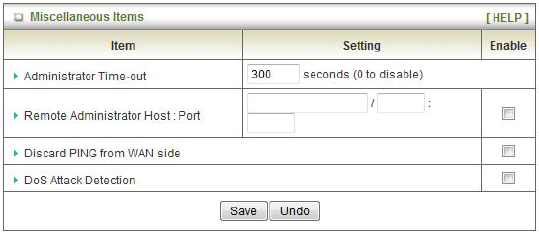
Security
Setting
>
Miscellaneous
This
page
allows
you
to
change
various
miscellaneous
security
settings
on
the
un
it.
Administrator Time-out
The period of time with no activity in the web configuration page to logout automatically, you may set it to zero to disable this feature.
Remote Administrator Host/Port
In general, only Intranet users can browse the built-in web pages to perform administration task. This feature enables you to perform administration tasks from a
remote host. If this feature is enabled, only the specified IP address can perform remote administration. If the specified IP address is 0.0.0.0, any host can connect
to the router to perform administration tasks. You can use subnet mask bit (/nn) notation to specify a group of trusted IP addresses for example, "10.1.2.0/24".
NOTE: When Remote Administration is enabled, the web server port will be shifted to 80. You can also change the web server port.
Discard PING from WAN side
When this feature is enabled, your router will not respond to ping requests from remote hosts.
DoS Attack Detection
When this feature is enabled, the router will detect and log where the DoS attack comes from on the Internet. Currently, the router can detect the following DoS
attack types: SYN Attack, WinNuke, Port Scan, Ping of Death and Land Attack, as well as others.
Click
“
Sa
ve”
to
sa
ve
the
settings
or
“
Undo”
to
cancel.
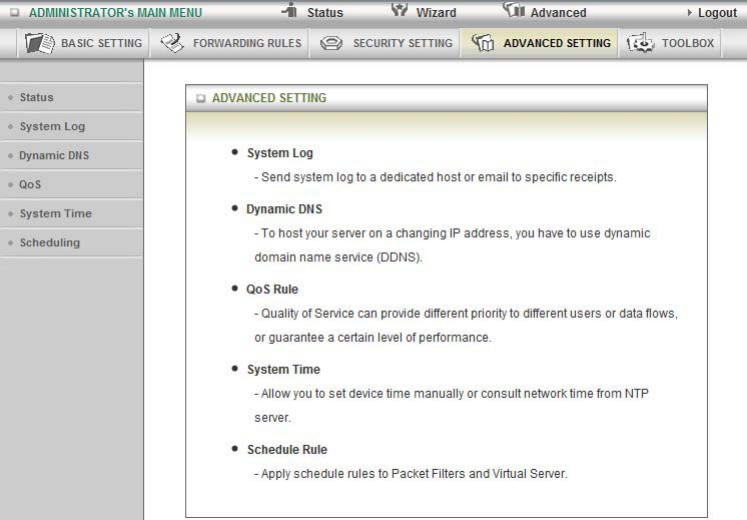
A
d
v
a
n
c
e
d
S
e
tt
i
ng
T
h
e
A
d
v
a
n
c
e
d
S
e
tt
i
ng
p
a
g
e
a
ll
o
w
s
y
o
u
t
o
c
o
n
fi
gu
r
e
t
h
e
a
d
v
a
n
c
e
d
s
e
tt
i
ng
s
o
n
t
h
e
router
s
u
c
h
a
s
the
S
y
s
t
e
m
l
o
g
,
D
y
n
a
mi
c
DN
S
a
nd
S
N
M
P options
.
C
li
ck
o
n
a
n
y
o
f
t
h
e
m
e
nu
items
o
n
t
h
e
l
e
ft
t
o
c
o
n
fi
gu
r
e
t
h
e
a
cc
e
ss
t
h
e
r
e
s
p
e
c
t
i
v
e
s
e
tt
i
ng
p
a
g
e
.
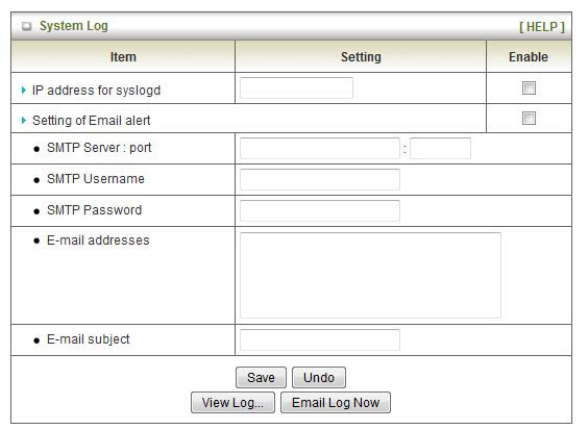
Adv
anced
Setting
>
System
Log
This enables you to set up the system log features of the router. You can also choose to export the system log via email (SMTP) or send it to a remote syslog server (UDP).
IP Address for Syslogd
Host IP of destination where sys log will be sent to. Check Enable to enable this function.
Setting of Email alert
Check if you want to enable Email alert (send syslog via email). Check Enable to enable this function.
SMTP Server IP and Port
Input the SMTP server IP and port, which are connected with ':'. If you do not specify port number, the default value is 25.For example, "mail.your_url.com" or "192.168.1.100:26".
SMTP Username and password
Input a user account and password for the SMTP server.
E-mail address
The recipients who will receive these logs, you can assign more than 1 recipient, using ';' or ',' to separate these email addresses.
E-mail Subject
The subject of email alert, this setting is optional.
View Log…
View the current system log.
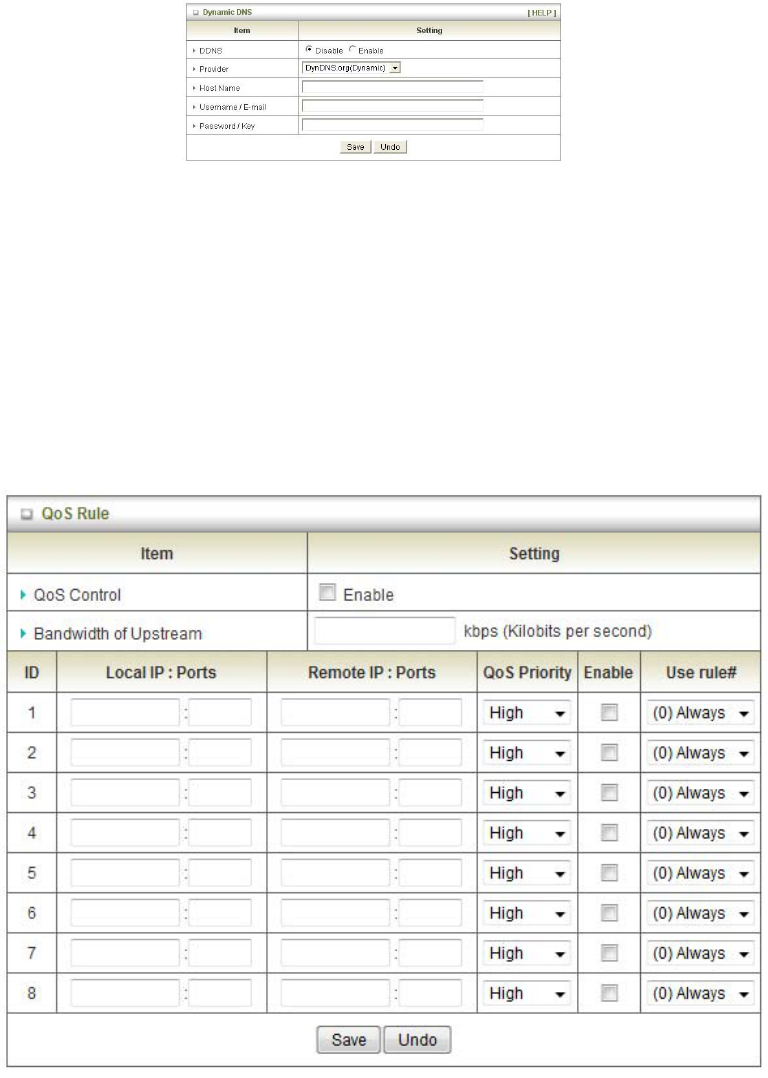
Adv
anced
Setting
>
Dynamic
DNS
The
Dynamic
DNS
fea
ture
ena
bles
users
to
ha
ve
a
sta
tic
domain
name
f
or
their
internet
connection
even
when
their
internet
connection
IP
address
is
dynamic.
By
mapping
the
host
name
to
the
current
public
IP
address
of
the router
,
users
who
want
to
connect
to
the
router
or
an
y
ser
vices
behind
the
router
from
the
internet
can
just
use
the
Dynamic
DNS
hostname
instead
of
the
IP
Address
which
might
change
ever
y
time
the
router
connects
to
the Internet.
Bef
ore
you
can
use
Dynamic
DNS
ser
vice,
you
need
to
register
an
account
on
one
of
the
man
y
supported
Dynamic
DNS
provider
such
as
DynDNS.org,
TZO.com
or
dhs.org.
After
registering
the
account,
the
Dynamic
DNS
provider
will
provide
you
with
the
f
ollowing
details:
•
Host
Name
•
Username/Email
•
Password/Ke
y
.
T
o
ena
ble
the
Dynamic
DNS
fea
ture
on
the
unit,
click
the
Ena
ble
check
box,
choose
the
respective
Provider
and
enter
the
details
from
your
provider
.
Click
“
Sa
ve”
to
sa
ve
the
settings
or
“
Undo”
to
cancel.
AdvancedSetting>QOS
QoS (Quality of Service) provides different priority to different users or data flows, or guarantees a certain level of performance.
QoS Control: This Item enables QoS function or not.
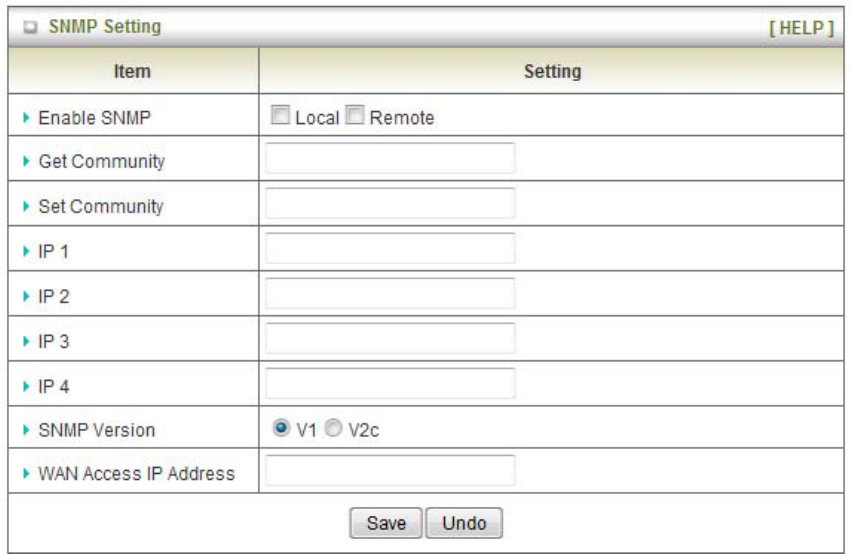
Bandwidth of Upstream: Set the limitation of upstream speed.
Local IP: Ports
Define the Local IP address and port to apply QoS to.
Remote IP: Ports
Define the Remote IP address and port to apply QoS to.
QoS Priority: This defines the priority level of the current Policy Configuration. Packets associated with this policy will be serviced based upon
the priority level set. For critical applications High or Normal levels are recommended. For non-critical applications select a Low level.
User Rule#: The QoS rules can work in conjunction with Scheduling Rules. Please reference the section Advanced setting/schedule Rule
section.
Click on “Save” to store your setting or “Undo” to discard your changes.
AdvancedSetting>SNMP
SNMP (Simple Network Management Protocol) is a protocol designed to give a user the capability to remotely manage a computer network by
polling and setting terminal values and monitoring network events.
Enable SNMP: You must check Local, Remote or both to enable SNMP function. If Local is checked, this device will only respond to requests
from LAN connected hosts. If Remote is checked, this device will respond to requests from the WAN connection.
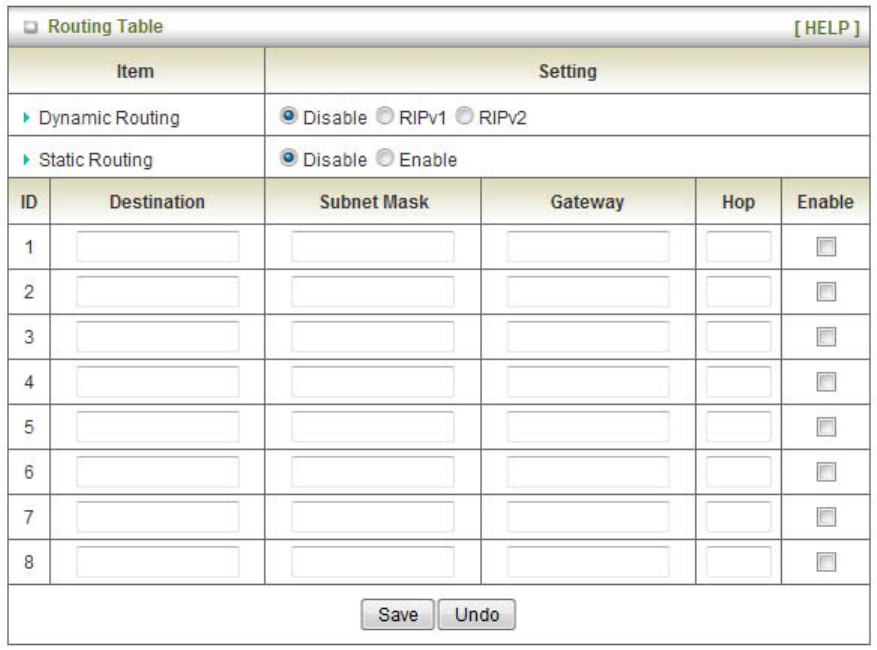
Get Community: Sets the community string your device will respond to for Read-Only access.
Set Community: Sets the community string your device will respond to for Read/Write access.
IP 1, IP 2, IP 3, IP 4: Input your SNMP Management host IP here. You will need to configure the address where the device should send SNMP
Trap messages to.
SNMP Version: Please select proper SNMP Version that your SNMP Management software supports.
WAN Access IP Address: You can limit remote access to a specific IP address by entering it here.
Please note: If "Remote" access is enabled, the default setting of 0.0.0.0 means any IP obtain SNMP protocol information.
Click on “Save” to store your setting or “Undo” to discard your changes.
AdvancedSetting>Routing
Routing tables allow you to determine which physical interface address to use for outgoing IP data. If you have more than one router and subnet, you will need to configure the routing
table to allow packets to find the proper routing path and allow different subnets to communicate with each other.
These settings are used to setup the static and dynamic routing features of the 3G25W-R.
Dynamic Routing:
Routing Information Protocol (RIP) will exchange information about different host destinations for working out routes throughout the network. Please only select RIPv2 if you have a
different subnet in your network. Otherwise, please select RIPv1.
Static Routing:
For static routing, you can specify up to 8 routing rules.
You need to enter the destination IP address, subnet mask, gateway, hop for each routing rule, and then enable the rule by clicking the Enable checkbox.
Click on “Save” to store your setting or “Undo” to discard your changes.
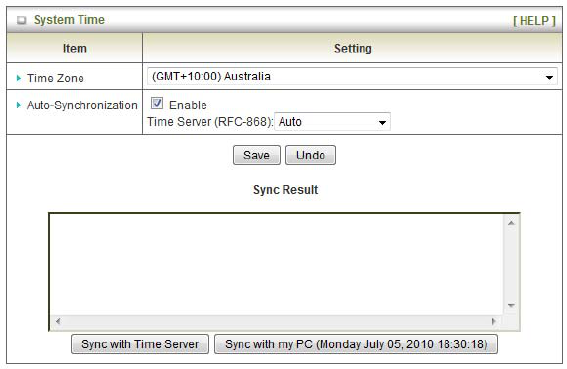
Adv
anced
Setting
>
System
T
ime
This
page
allows
you
to
change
the
System
time
setting
on
the
3G25W-R
.
Time Zone
Select the time zone where this device is located.
Auto-Synchronization
Select the “Enable” checkbox to enable this function.
Time Server
Select a NTP time server to obtain the current UTC time from
Sync with Time Server
Select if you want to set Date and Time by NTP Protocol.
Sync with my PC
Select if you want to set Date and Time using your computers Date and Time
Click
“
Sa
ve”
to
sa
ve
the
settings
or
“
Undo”
to
cancel.
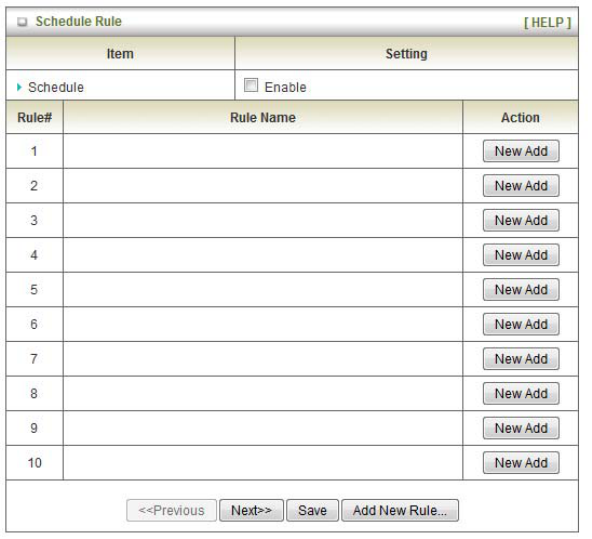
Adv
anced
Setting
>
Sc
heduling
You can use scheduling to enable or disable a service at a specific time or on a specific day.
Select “Enable” and then click the “New Add” button.
Select a name for the rule and enter the details such as the day, start time or end time.
Click
“
Sa
ve”
to
sa
ve
the
settings
or
“
Undo”
to
cancel.
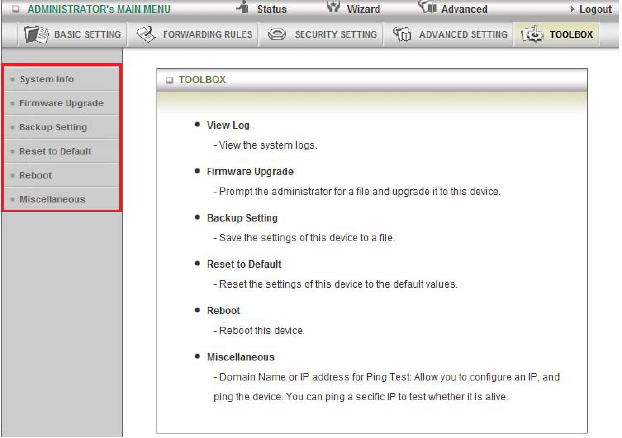
T
oo
l
B
o
x
The
T
ool
Box
page
consists
of
various
tools
f
or
the
unit.
Click
on
an
y
of
the
menu
items
on
the
left
to
access
the
respective
pa
ge.
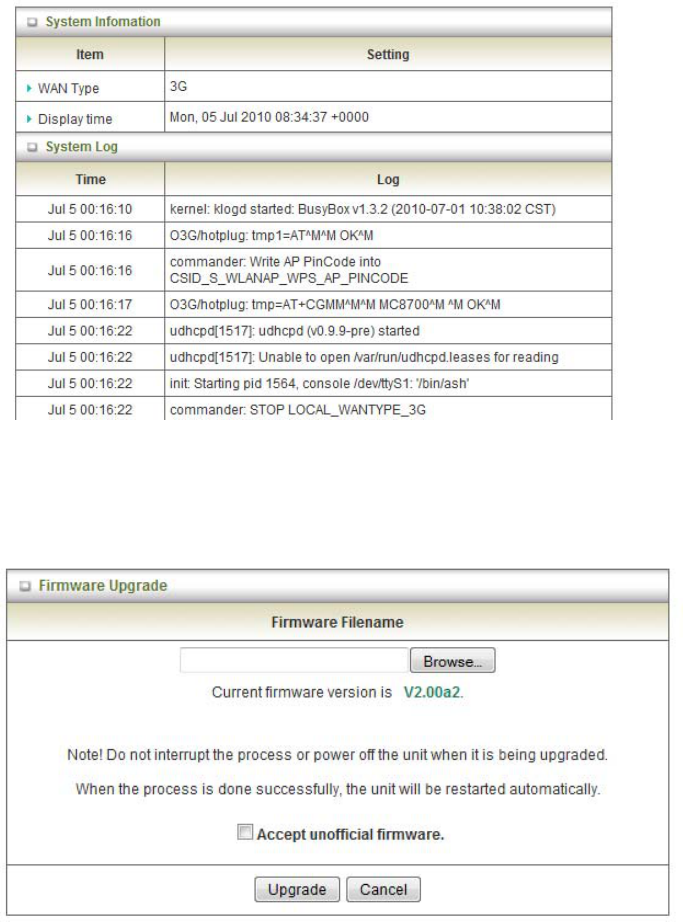
T
ool
Box
>
System
Info
From
this
page
you
can
view
the
System
log
and
the
Routing
T
a
ble
information for
the
router.
T
ool
Box
>
FirmwareUpgrade
You can upgrade the routers firmware by clicking the “Upgrade” button
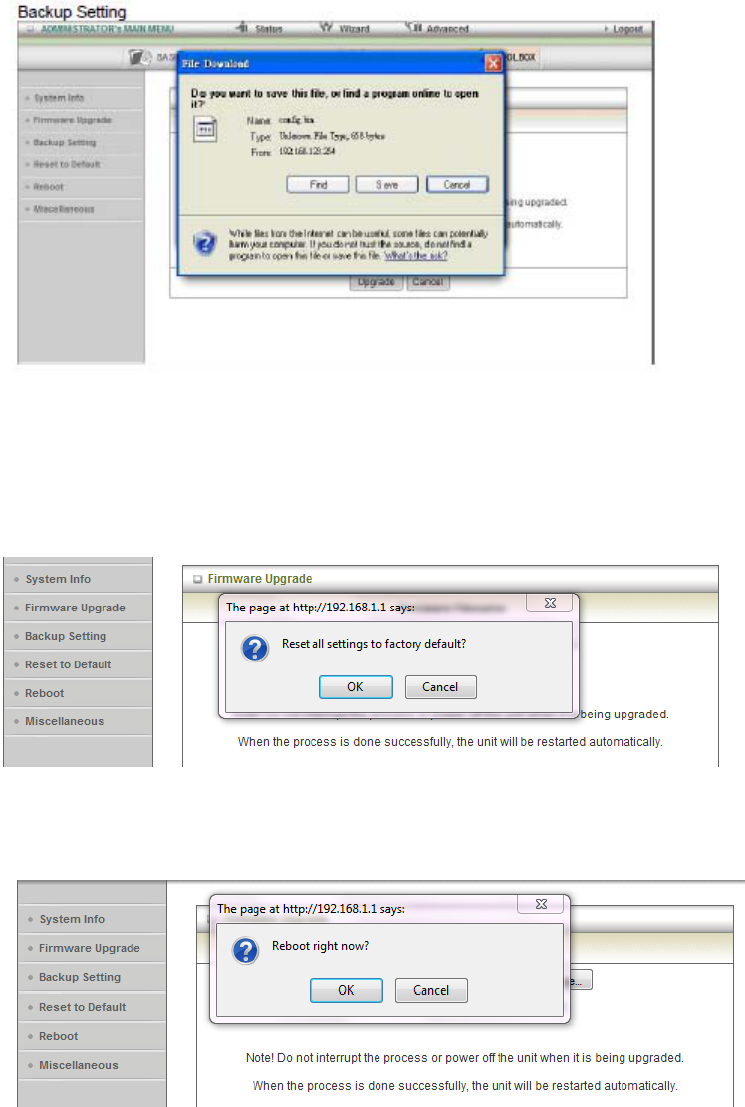
T
ool
Box
>
Backup
Setting
You
can backup your current settings by clicking the “
Backup Setting
” button then and save it as a bin file. When you want to restore these settings,
click the “Firmware Upgrade” button and use the bin file you saved.
T
ool
Box
>
ResettoDefault
Tool
Box
>
Reboot
AppendixA:
WANFailover
The WAN failover feature of the 3G25W-R is designed to provide a backup WAN connection in case your primary connection should fail. To use this feature, you
will require both a regular WAN connection and a 3G WAN connection.
Please follow these steps to set up WAN failover on your 3G25W-R.
1. Set up a primary (non-3G) WAN connection by following the steps outlined in the Basic Setting > Primary Setup section of the User Guide.
2. Set up a secondary (3G) WAN connection by following the steps outlined in the Basic Setting > Primary Setup section of the User Guide.
3. Open your web browser (e.g. Internet Explorer/Firefox/Safari) and navigate to http://192.168.1.1/.
4. At the login screen, type in “admin” (without quotes) in the System Password field. Then click on Login.
5. Navigate to the Basic Setting > Primary Setup page. Select the Activate WWAN for Auto-Failover checkbox and enter a public IP address (for example
‘www.google.com’) into the remote host for keep alive box. The 3G25W-R will periodically check that it can connect to this address to determine if the WAN
connection is still running.
6. In Basic Setting > Primary Setup, make sure that the selected WAN Type is your primary (non-3G) WAN connection and click Save. You are now ready to use
the internet connection as normal.
7. When your primary (non-3G) WAN connection fails, the 3G25W-R will automatically failover to the secondary (3G) WAN connection. Please allow up to 2
minutes for this change to occur.
8. When your primary (non-3G) WAN connection reconnects, the 3G25W-R will automatically revert to this connection. Please allow up to 2 minutes for this change
to occur.
9. To confirm that the process in Step 8 is complete, refresh the status page of the web interface after 1 minute.
AppendixB:EstablishingyourWirelessConnection
WindowsXPservicepack2
1. Open Network Connections (Start -> Control Panel -> Network Connections):
2. Right-click on your Wireless Network Connection and select View Available Wireless Networks:
3. Select the wireless network you want to connect to and click Connect:
4. Enter the network key (“a1b2b3d4e5”) and click Connect:
5. The connection will show Connected.
WindowsVista
1. Open Network and Sharing Center (Start > Control Panel > Network and Sharing center).
2. Click on “Connect to a network”.
3. Choose “Connect to the Internet” and click on “Next”.
4. Choose “NetComm n3G Series”.
5. Click on the wireless network name and click “Connect”.
6. Click on “Display Characters” and type in the network key. Then Click “Next”.
7. Select the appropriate location. This will affect the firewall settings on the computer.
8. Click on both “Save this network” and “Start this connection automatically” and click “Next”.
Windows7
Follow these steps:
1. Open Network and Sharing Center (Start > Control Panel > Network and Sharing center).
2. Click on "Change Adapter settings" on the left-hand side.
3. Right-click on "Wireless Network Connection" and select "Connect / Disconnect".
4. You should see a network listed with the SSID of your 3G25W-R. Select your wireless network and click “Connect”.
5. Type the following into the “Security key” section: a1b2c3d4e5 and click "OK".
6. You may then see a window that asks you to "Select a location for the 'wireless' network". Please select the "Home" location.
7. You may then see a window prompting you to setup a “HomeGroup”. Click “Cancel” on this.
8. You can verify your wireless connection by clicking the “Wireless Signal” indicator in your system tray. After clicking on this, you should see an
entry matching the SSID of your 3G25W-R with “Connected” next to it.
MacOSX10.6
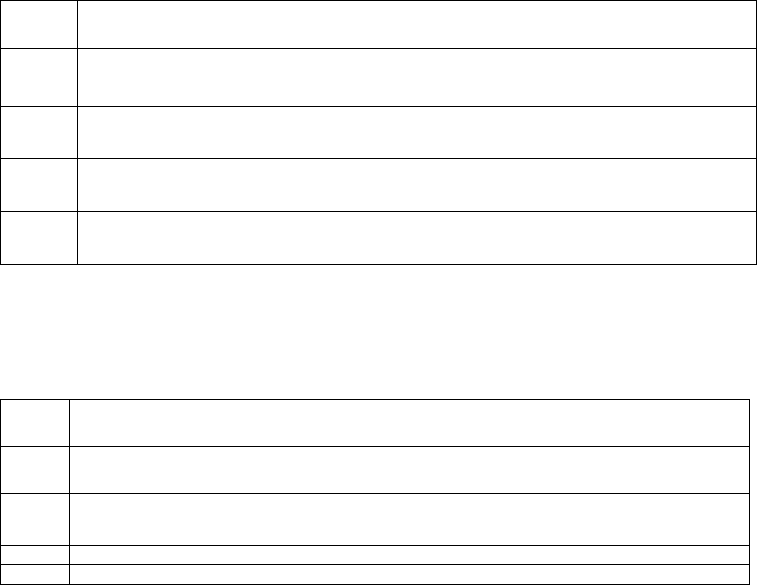
Follow these steps:
1. Click on the Airport icon on the top right menu.
2. Click on the network name that you want to connect.
3. On the new window, tick on Show Password and type in the network key in the Password field. Click on OK.
4. To check the connection, click on the Airport icon and there should be a tick on the wireless name.
Notes:Forotheroperatingsystem(Windows98SE,WindowsME,Windows2000etc)orifyouusethewireless
adaptorutilitytoconfigureyourwirelessconnection,pleaseconsultthewirelessadapterdocumentationfor
additionalinformation.
AppendixC:Troubleshooting
UsingLEDstoDiagnoseProblems
The LEDs are useful aides for finding possible problem causes.
Power LED
The Power LED does not light up.
StepCorrect Action
1Make sure that the 3G25W-R power adaptor is connected to the device and plugged in to an appropriate power
source. Use only the supplied power adaptor.
2Check that the 3G25W-R and the power source are both turned on and device is receiving sufficient power.
3Turn the 3G25W-R off and on.
4If the error persists, you may have a hardware problem. In this case, you should contact your vendor.
WebConfiguration
I cannot access the web configuration.
STEPS CORRECTIVE ACTION
Step Correct Action
1 Make sure you are using the correct IP address of the 3G25W-R. Check the IP address of the device.
2 Check that you have enabled web service access. If you have configured a secured client IP address, your computer’s
IP address must match it.
3 Your computer’s and the 3G25W-R’s IP addresses must be on the same subnet for LAN access.
4 If you changed the devices WLAN IP address, then enter the new one as the URL.
S The web configuration does not display properly.

Step Correct Action
1 Delete the temporary web files and log in again. In Internet Explorer, click Tools, Internet Options and then
click the Delete Files ... button. When a Delete Files window displays, select Delete all offline content and
click OK. (Steps may vary depending on the version of your Internet browser.)
CORRECTIVE ACTION
LoginUsernameandPassword
I forgot my login username and/or password.
S
Step Correct Action
1 If you have changed the password and have now forgotten it, you will need to upload the default configuration file.
This will erase all custom configurations and restore all of the factory defaults including the password.
2 Press the Reset button for ten seconds, and then release it. When the LINK LED begins to blink, the defaults have
been restored and the 3G25W-R restarts.
3 The default username is “admin”. The default password is “admin”. The Password and Username fields are case-
sensitive. Make sure that you enter the correct password and username using the proper casing.
4 It is highly recommended to change the default username and password. Make sure you store the username and
password in a save place.
S CORRECTIVE ACTION
WLANInterface
I cannot access the 3G25W-R from the WLAN or ping any computer on the WLAN.
Step Correct Action
1 Check the WiFi LEDs on top of the unit
2 Make sure that the IP address and the subnet mask of the NB14WN and your computer(s) are on the same subnet.
TE CORRECTIVE ACTION
InternetAccess
I cannot access the Internet.
STEPS COR
Step Correct Action
1 Make sure the 3G25W-R is turned on and connected to the network.
2 Verify your 3G settings
RECTIVE ACTION
Internetconnectiondisconnects.
S
Step Correct Action
1 Check the schedule rules.
2 Contact your 3G SIM provider
TEPS CORRECTIVE ACTION
LegalandRegulatoryInformation
FCC Statement:
This equipment has been tested and found to comply with the limits for a Class B digital device, pursuant to Part 15 of the FCC Rules.
These limits are designed to provide reasonable protection against harmful interference in a residential installation. This equipment generates,
uses and can radiate radio frequency energy and, if not installed and used in accordance with the instructions, may cause harmful interference
to radio or television reception, which can be determined by turning the equipment off and on, the user is encouraged to try to correct the
interference by one of the following measures:
Reorient or relocate the receiving antenna.
Increase the separation between the equipment and receiver.
Connect the equipment into an outlet on a circuit different from that to which the receiver is connected.
Consult the dealer or an experienced radio/TV technician for help.
FCC Caution:
Any changes or modifications not expressly approved by the party responsible for compliance could void the user’s authority to operate this
equipment.
This device complies with Part 15 of the FCC Rules. Operation is subject to the following two conditions:
1. This device may not cause harmful interference, and
2. this device must accept any interference received, including interference that may cause undesired operation.
Important Note:
FCC Radiation Exposure Statement:
This equipment complies with FCC radiation exposure limits set forth for an uncontrolled environment. This equipment should be installed and
operated with a minimum distance of 20cm between the radiator and your body.
The transmitter must not be co-located or operating in conjunction with any other antenna or transmitter.

Industry Canada RF exposure requirements
In order to ensure compliance with the RF exposure requirements specified in Health Canada Safety Code 6, this device may
be operated while held in the hand, but not when held close to the body, carried in a pocket or holster, or similar configuration
that allows close proximity to the body.”
NOTE: THE MANUFACTURER IS NOT RESPONSIBLE FOR ANY RADIO OR TV INTERFERENCE CAUSED BY UNAUTHORIZED
MODIFICATIONS TO THIS EQUIPMENT. SUCH MODIFICATIONS COULD VOID THE USER'S AUTHORITY TO OPERATE THE
EQUIPMENT.
ThisdevicecomplieswithIndustryCanadalicence‐exemptRSSstandard(s).
Operationissubjecttothefollowingtwoconditions:
(1)thisdevicemaynotcauseinterference
(2)thisdevicemustacceptanyinterference,includinginterferencethatmaycauseundesiredoperationofthedevice.
This Class [ B ] digital apparatus complies with Canadian ICES-003.
This device has been designed to operate with the antennas listed below, and having a maximum gain of [ 4 ]dB.
Antennas not included in this list or having a gain greater than [ 4 ]dB are strictly prohibited for use with this device. The
required antenna impedance is [ 50 ] ohms.

This product includes copyrighted third-party software licensed under the terms of the GNU General Public License.
Please refer to the GNU General Public License below to check the detailed terms of this license.
The following parts of this product are subject to the GNU GPL, and those software packages are copyright by their
respective authors.
Linux-2.6.21 system kernel
busybox_1_00_rc2
bridge-utils 0.9.5
dhcpcd-1.3
ISC DHCP V2 P5
syslogd spread from busybox
wireless tools
ntpclient of NTP client implementation
GNU Wget
Availability of source code
Please visit our web site or contact us to obtain more information.
GNU GENERAL PUBLIC LICENSE
Version 2, June 1991
Copyright (C) 1989, 1991 Free Software Foundation, Inc.
59 Temple Place, Suite 330, Boston, MA 02111-1307 USA
Everyone is permitted to copy and distribute verbatim copies
of this license document, but changing it is not allowed.
Preamble
The licenses for most software are designed to take away your freedom to share and change it. By contrast, the
GNU General Public License is intended to guarantee your freedom to share and change free software--to make
sure the software is free for all its users. This General Public License applies to most of the Free Software
Foundation's software and to any other program whose authors commit to using it. (Some other Free Software
Foundation software is covered by the GNU Library General Public License instead.) You can apply it to your
programs, too.
When we speak of free software, we are referring to freedom, not price. Our General Public Licenses are designed
to make sure that you have the freedom to distribute copies of free software (and charge for this service if you wish),
that you receive source code or can get it if you want it, that you can change the software or use pieces of it in new
free programs; and that you know you can do these things.
To protect your rights, we need to make restrictions that forbid anyone to deny you these rights or to ask you to
surrender the rights. These restrictions translate to certain responsibilities for you if you distribute copies of the
software, or if you modify it.
For example, if you distribute copies of such a program, whether gratis or for a fee, you must give the recipients all
the rights that you have. You must make sure that they, too, receive or can get the source code. And you must
show them these terms so they know their rights.
We protect your rights with two steps: (1) copyright the software, and (2) offer you this license which gives you legal
permission to copy, distribute and/or modify the software.
Also, for each author's protection and ours, we want to make certain that everyone understands that there is no
warranty for this free software. If the software is modified by someone else and passed on, we want its recipients to
know that what they have is not the original, so that any problems introduced by others will not reflect on the original
authors' reputations.
Finally, any free program is threatened constantly by software patents. We wish to avoid the danger that
redistributors of a free program will individually obtain patent licenses, in effect making the program proprietary. To
prevent this, we have made it clear that any patent must be licensed for everyone's free use or not licensed at all.
The precise terms and conditions for copying, distribution and modification follow.
GNU GENERAL PUBLIC LICENSE
TERMS AND CONDITIONS FOR COPYING, DISTRIBUTION AND MODIFICATION
0. This License applies to any program or other work which contains a notice placed by the copyright holder saying
it may be distributed under the terms of this General Public License. The "Program", below, refers to any such
program or work, and a "work based on the Program" means either the Program or any derivative work under
copyright law: that is to say, a work containing the Program or a portion of it, either verbatim or with modifications
and/or translated into another language. (Hereinafter, translation is included without limitation in the term
"modification".) Each licensee is addressed as "you".
Activities other than copying, distribution and modification are not covered by this License; they are outside its
scope. The act of running the Program is not restricted, and the output from the Program is covered only if its
contents constitute a work based on the Program (independent of having been made by running the Program).
Whether that is true depends on what the Program does.
1. You may copy and distribute verbatim copies of the Program's source code as you receive it, in any medium,
provided that you conspicuously and appropriately publish on each copy an appropriate copyright notice and
disclaimer of warranty; keep intact all the notices that refer to this License and to the absence of any warranty; and
give any other recipients of the Program a copy of this License along with the Program.
You may charge a fee for the physical act of transferring a copy, and you may at your option offer warranty
protection in exchange for a fee.
2. You may modify your copy or copies of the Program or any portion of it, thus forming a work based on the
Program, and copy and distribute such modifications or work under the terms of Section 1 above, provided that you
also meet all of these conditions:
You must cause the modified files to carry prominent notices stating that you changed the files and the date
of any change.
You must cause any work that you distribute or publish, that in whole or in part contains or is derived from
the Program or any part thereof, to be licensed as a whole at no charge to all third parties under the terms of this
License.
If the modified program normally reads commands interactively when run, you must cause it, when started
running for such interactive use in the most ordinary way, to print or display an announcement including an
appropriate copyright notice and a notice that there is no warranty (or else, saying that you provide a warranty) and
that users may redistribute the program under these conditions, and telling the user how to view a copy of this
License. (Exception: if the Program itself is interactive but does not normally print such an announcement, your
work based on the Program is not required to print an announcement.)
These requirements apply to the modified work as a whole. If identifiable sections of that work are not derived from
the Program, and can be reasonably considered independent and separate works in themselves, then this License,
and its terms, do not apply to those sections when you distribute them as separate works. But when you distribute
the same sections as part of a whole which is a work based on the Program, the distribution of the whole must be
on the terms of this License, whose permissions for other licensees extend to the entire whole, and thus to each
and every part regardless of who wrote it.
Thus, it is not the intent of this section to claim rights or contest your rights to work written entirely by you; rather,
the intent is to exercise the right to control the distribution of derivative or collective works based on the Program.
In addition, mere aggregation of another work not based on the Program with the Program (or with a work based on
the Program) on a volume of a storage or distribution medium does not bring the other work under the scope of this
License.
3. You may copy and distribute the Program (or a work based on it, under Section 2) in object code or executable
form under the terms of Sections 1 and 2 above provided that you also do one of the following:
Accompany it with the complete corresponding machine-readable source code, which must be distributed
under the terms of Sections 1 and 2 above on a medium customarily used for software interchange; or,
Accompany it with a written offer, valid for at least three years, to give any third party, for a charge no more
than your cost of physically performing source distribution, a complete machine-readable copy of the corresponding
source code, to be distributed under the terms of Sections 1 and 2 above on a medium customarily used for
software interchange; or,
Accompany it with the information you received as to the offer to distribute corresponding source code.
(This alternative is allowed only for noncommercial distribution and only if you received the program in object code
or executable form with such an offer, in accord with Subsection b above.)
The source code for a work means the preferred form of the work for making modifications to it. For an executable
work, complete source code means all the source code for all modules it contains, plus any associated interface
definition files, plus the scripts used to control compilation and installation of the executable. However, as a special
exception, the source code distributed need not include anything that is normally distributed (in either source or
binary form) with the major components (compiler, kernel, and so on) of the operating system on which the
executable runs, unless that component itself accompanies the executable.
If distribution of executable or object code is made by offering access to copy from a designated place, then offering
equivalent access to copy the source code from the same place counts as distribution of the source code, even
though third parties are not compelled to copy the source along with the object code.
4. You may not copy, modify, sublicense, or distribute the Program except as expressly provided under this License.
Any attempt otherwise to copy, modify, sublicense or distribute the Program is void, and will automatically terminate
your rights under this License. However, parties who have received copies, or rights, from you under this License
will not have their licenses terminated so long as such parties remain in full compliance.
5. You are not required to accept this License, since you have not signed it. However, nothing else grants you
permission to modify or distribute the Program or its derivative works. These actions are prohibited by law if you do
not accept this License. Therefore, by modifying or distributing the Program (or any work based on the Program),
you indicate your acceptance of this License to do so, and all its terms and conditions for copying, distributing or
modifying the Program or works based on it.
6. Each time you redistribute the Program (or any work based on the Program), the recipient automatically receives
a license from the original licensor to copy, distribute or modify the Program subject to these terms and conditions.
You may not impose any further restrictions on the recipients' exercise of the rights granted herein. You are not
responsible for enforcing compliance by third parties to this License.
7. If, as a consequence of a court judgment or allegation of patent infringement or for any other reason (not limited
to patent issues), conditions are imposed on you (whether by court order, agreement or otherwise) that contradict
the conditions of this License, they do not excuse you from the conditions of this License. If you cannot distribute so
as to satisfy simultaneously your obligations under this License and any other pertinent obligations, then as a
consequence you may not distribute the Program at all. For example, if a patent license would not permit royalty-
free redistribution of the Program by all those who receive copies directly or indirectly through you, then the only
way you could satisfy both it and this License would be to refrain entirely from distribution of the Program.
If any portion of this section is held invalid or unenforceable under any particular circumstance, the balance of the
section is intended to apply and the section as a whole is intended to apply
in other circumstances.
It is not the purpose of this section to induce you to infringe any patents or other property right claims or to contest
validity of any such claims; this section has the sole purpose of protecting the integrity of the free software
distribution system, which is implemented by public license practices. Many people have made generous
contributions to the wide range of software distributed through that system in reliance on consistent application of
that system; it is up to the author/donor to decide if he or she is willing to distribute software through any other
system and a licensee cannot impose that choice.
This section is intended to make thoroughly clear what is believed to be a consequence of the rest of this License.
8. If the distribution and/or use of the Program is restricted in certain countries either by patents or by copyrighted
interfaces, the original copyright holder who places the Program under this License may add an explicit
geographical distribution limitation excluding those countries, so that distribution is permitted only in or among
countries not thus excluded. In such case, this License incorporates the limitation as if written in the body of this
License.
9. The Free Software Foundation may publish revised and/or new versions of the General Public License from time
to time. Such new versions will be similar in spirit to the present version, but may differ in detail to address new
problems or concerns.
Each version is given a distinguishing version number. If the Program specifies a version number of this License
which applies to it and "any later version", you have the option of following the terms and conditions either of that
version or of any later version published by the Free Software Foundation. If the Program does not specify a version
number of this License, you may choose any version ever published by the Free Software Foundation.
10. If you wish to incorporate parts of the Program into other free programs whose distribution conditions are
different, write to the author to ask for permission. For software which is copyrighted by the Free Software
Foundation, write to the Free Software Foundation; we sometimes make exceptions for this. Our decision will be
guided by the two goals of preserving the free status of all derivatives of our free software and of promoting the
sharing and reuse of software generally.
NO WARRANTY
11. BECAUSE THE PROGRAM IS LICENSED FREE OF CHARGE, THERE IS NO WARRANTY FOR THE
PROGRAM, TO THE EXTENT PERMITTED BY APPLICABLE LAW. EXCEPT WHEN OTHERWISE STATED IN
WRITING THE COPYRIGHT HOLDERS AND/OR OTHER PARTIES PROVIDE THE PROGRAM "AS IS"
WITHOUT WARRANTY OF ANY KIND, EITHER EXPRESSED OR IMPLIED, INCLUDING, BUT NOT LIMITED TO,
THE IMPLIED WARRANTIES OF MERCHANTABILITY AND FITNESS FOR A PARTICULAR PURPOSE. THE
ENTIRE RISK AS TO THE QUALITY AND PERFORMANCE OF THE PROGRAM IS WITH YOU. SHOULD THE
PROGRAM PROVE DEFECTIVE, YOU ASSUME THE COST OF ALL NECESSARY SERVICING, REPAIR OR
CORRECTION.
12. IN NO EVENT UNLESS REQUIRED BY APPLICABLE LAW OR AGREED TO IN WRITING WILL ANY
COPYRIGHT HOLDER, OR ANY OTHER PARTY WHO MAY MODIFY AND/OR REDISTRIBUTE THE PROGRAM
AS PERMITTED ABOVE, BE LIABLE TO YOU FOR DAMAGES,
INCLUDING ANY GENERAL, SPECIAL, INCIDENTAL OR CONSEQUENTIAL DAMAGES ARISING OUT OF THE
USE OR INABILITY TO USE THE PROGRAM (INCLUDING BUT NOT LIMITED TO LOSS OF DATA OR DATA
BEING RENDERED INACCURATE OR LOSSES SUSTAINED BY YOU OR THIRD PARTIES OR A FAILURE OF
THE PROGRAM TO OPERATE WITH ANY OTHER PROGRAMS), EVEN IF SUCH HOLDER OR OTHER PARTY
HAS BEEN ADVISED OF THE POSSIBILITY OF SUCH DAMAGES.
END OF TERMS AND CONDITIONS